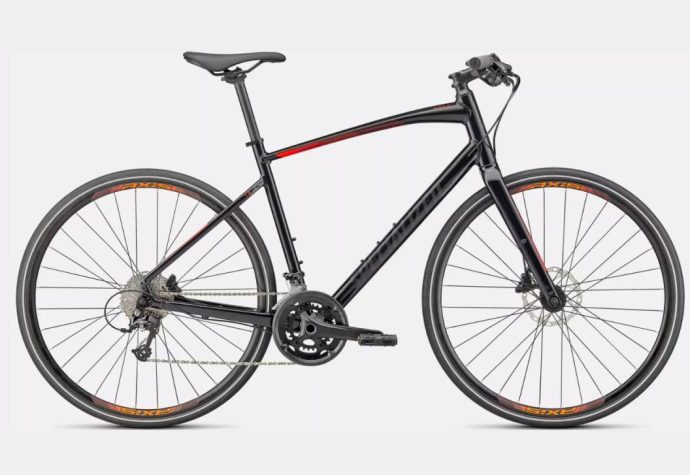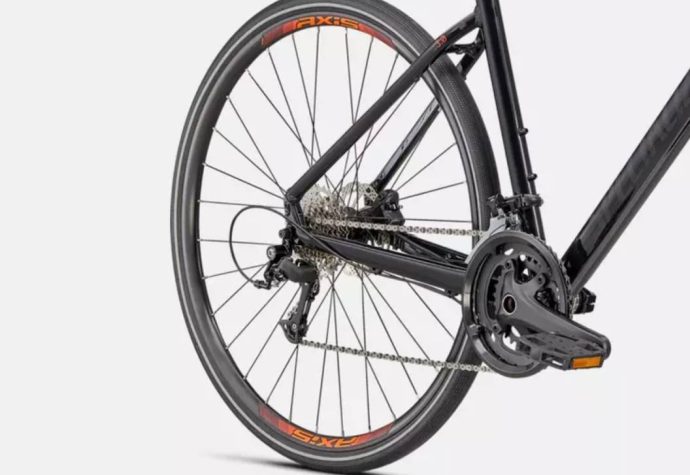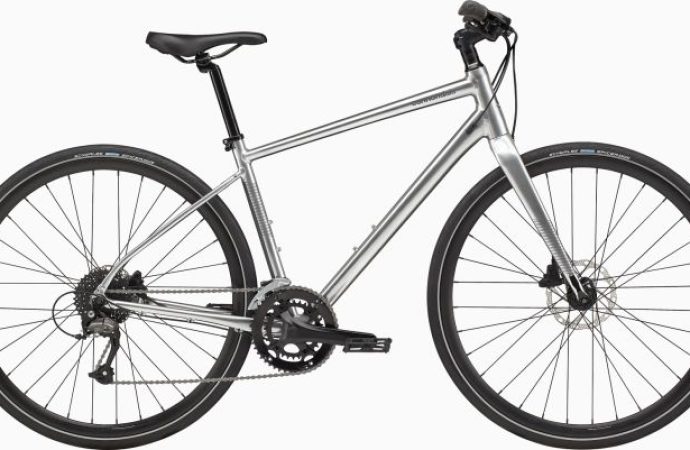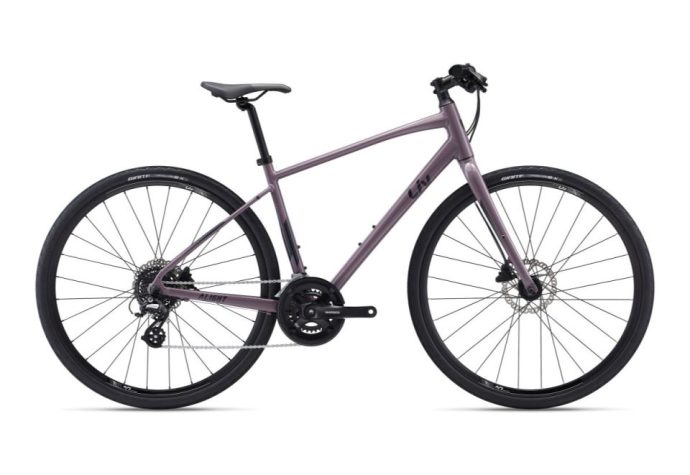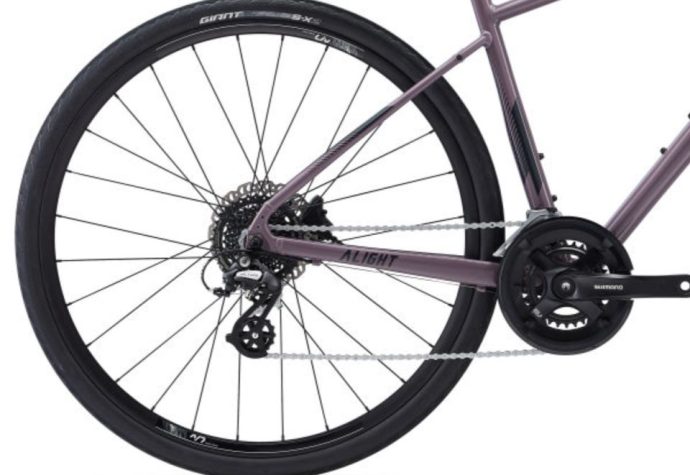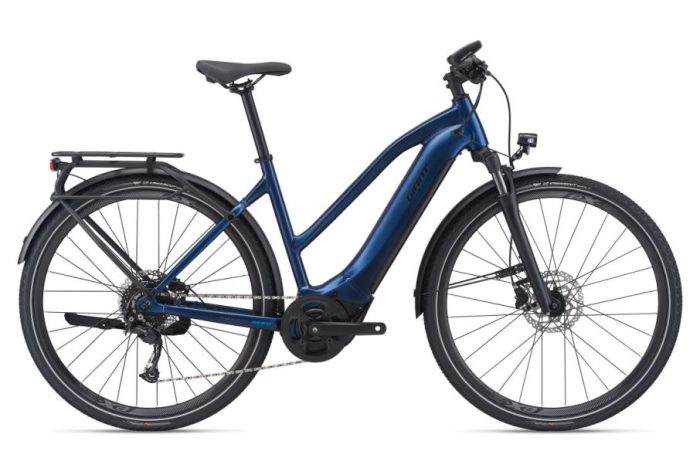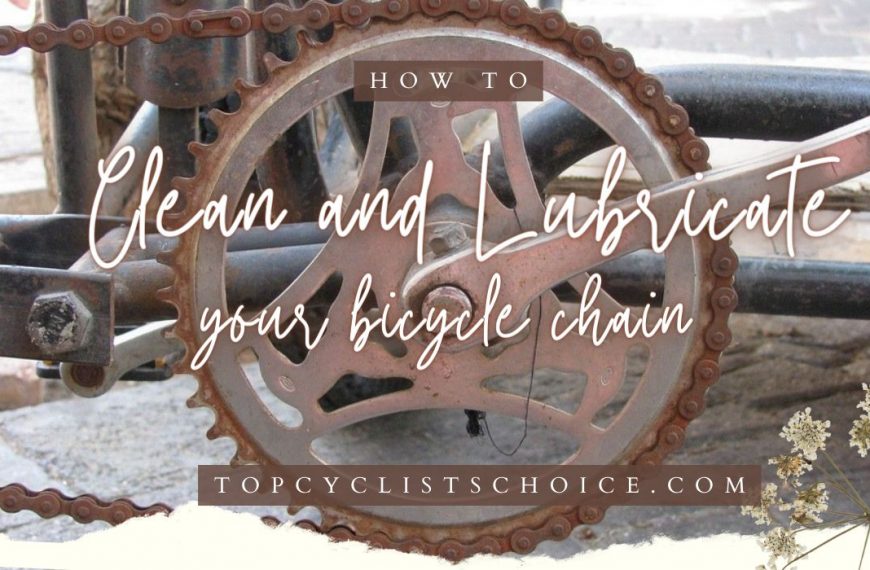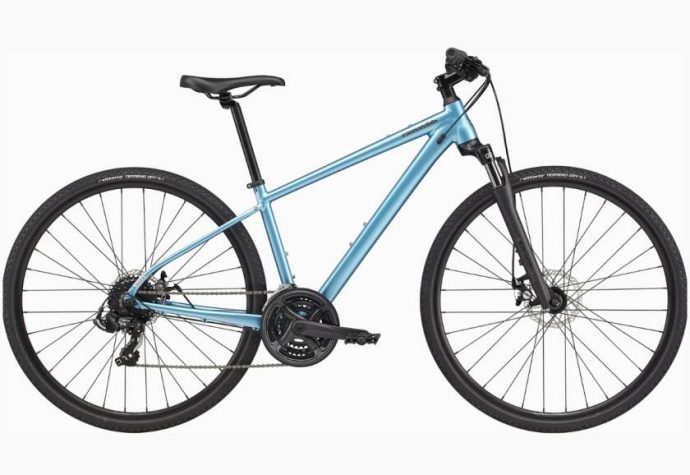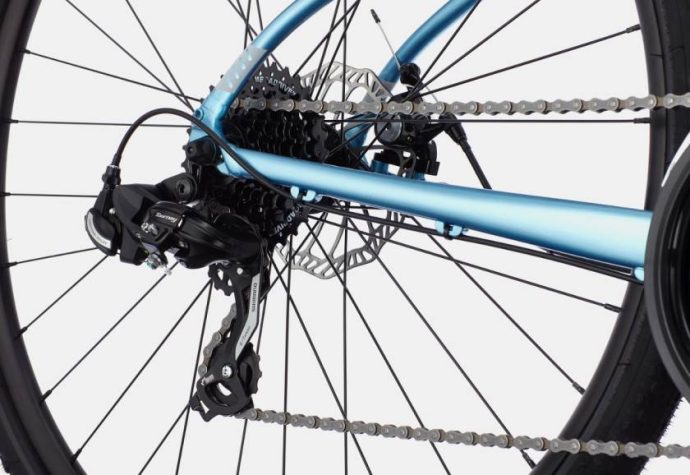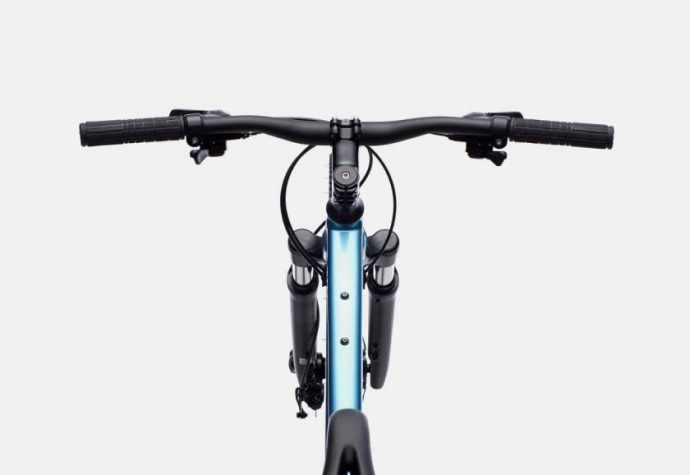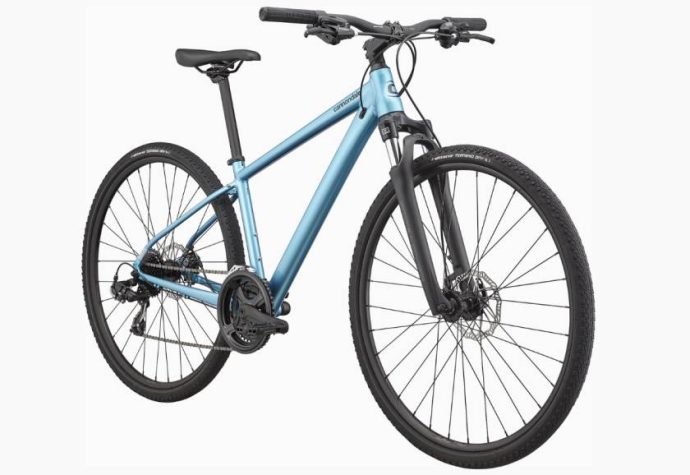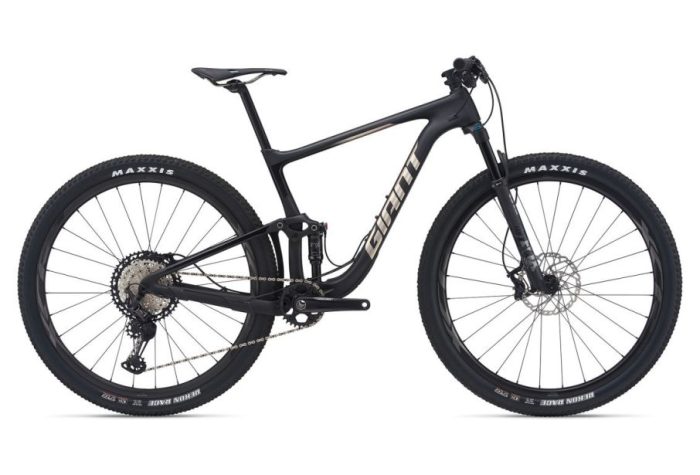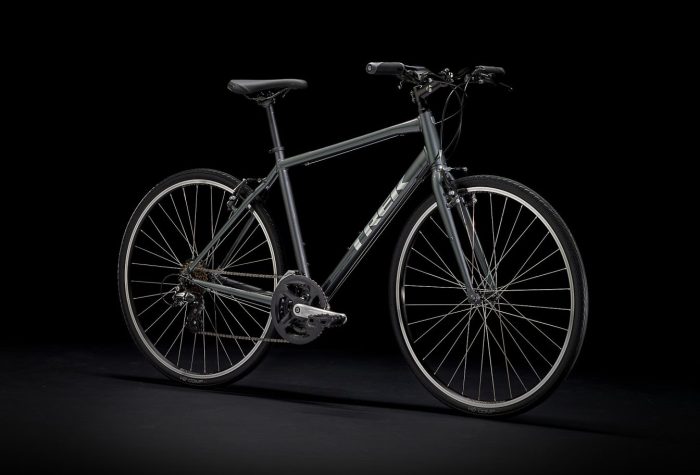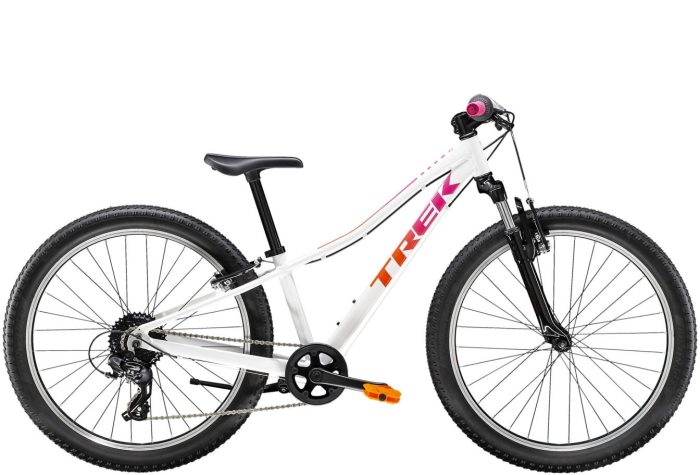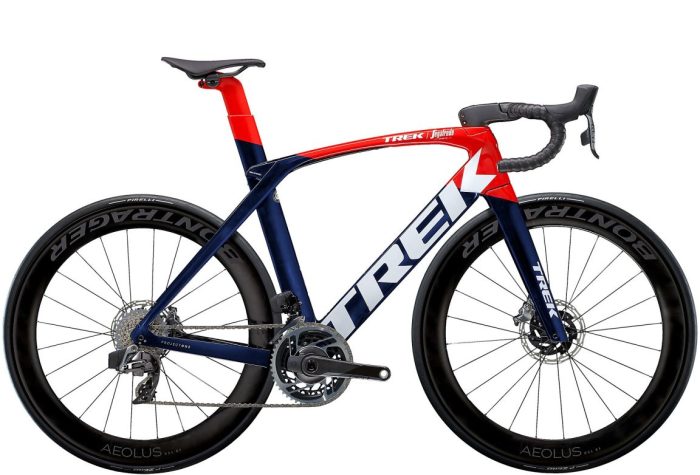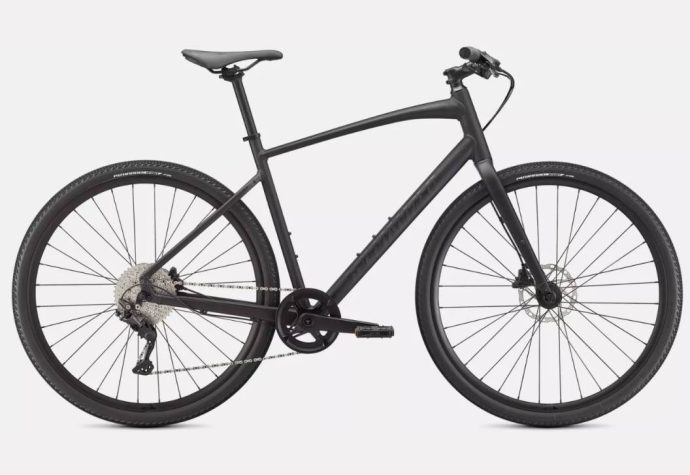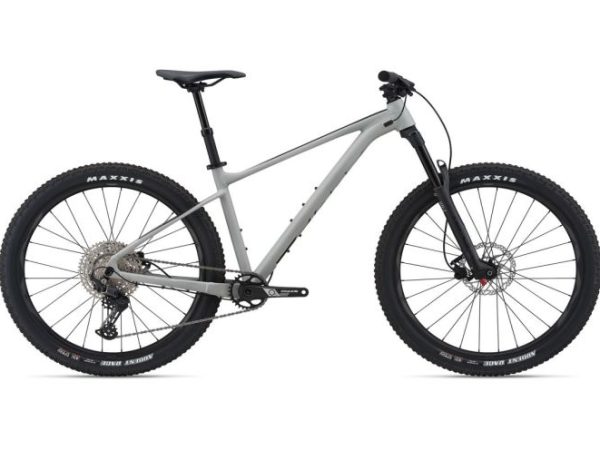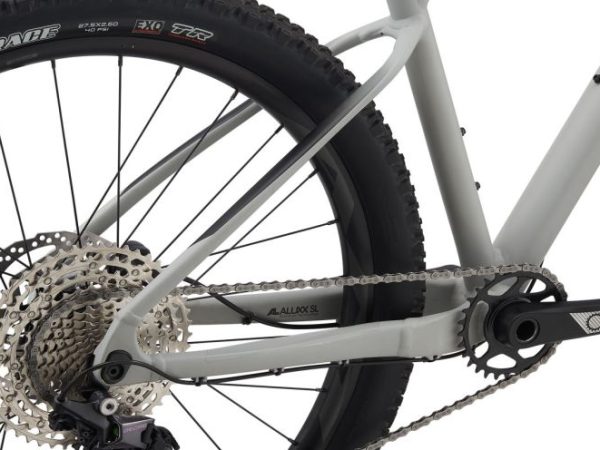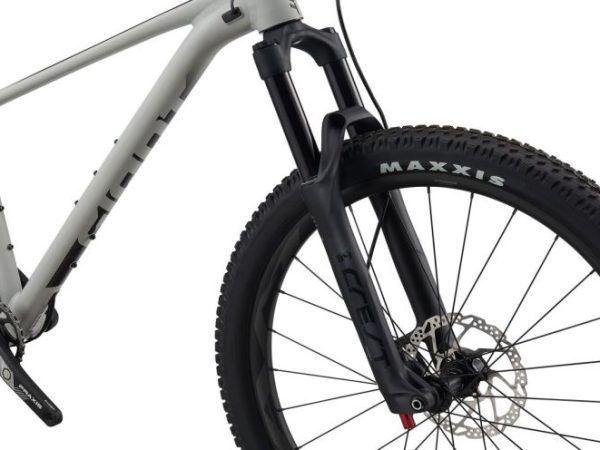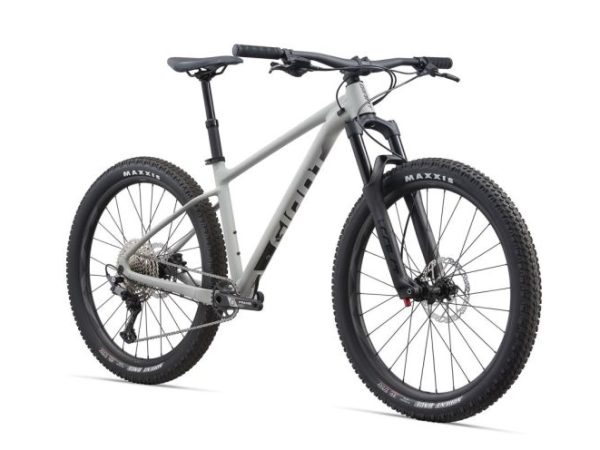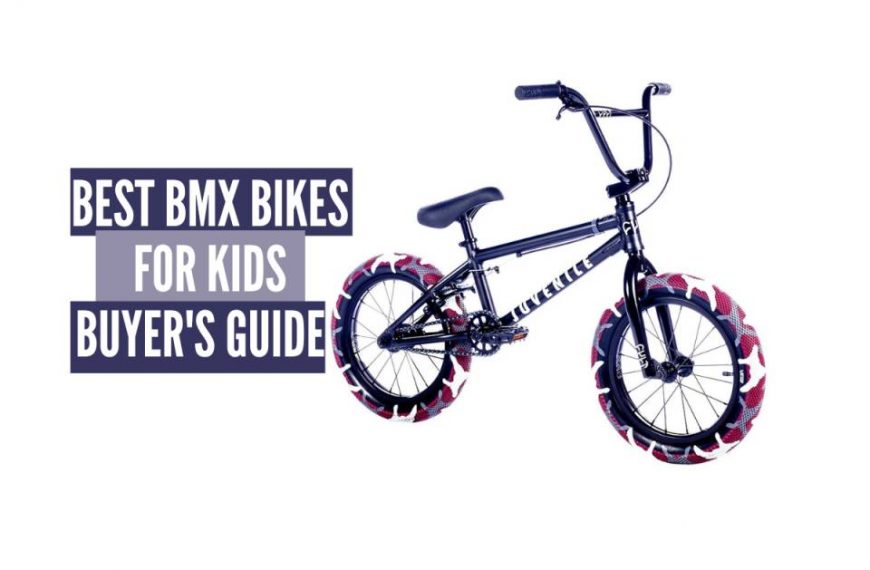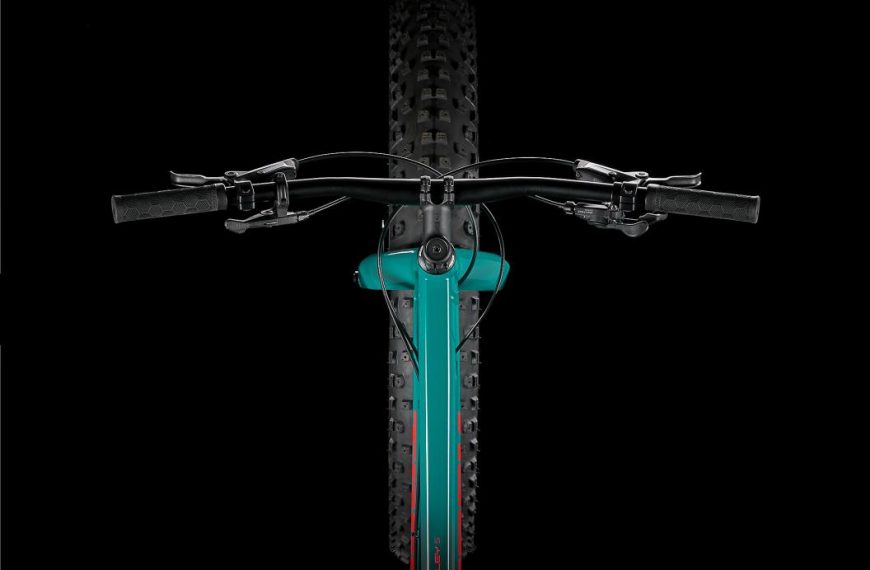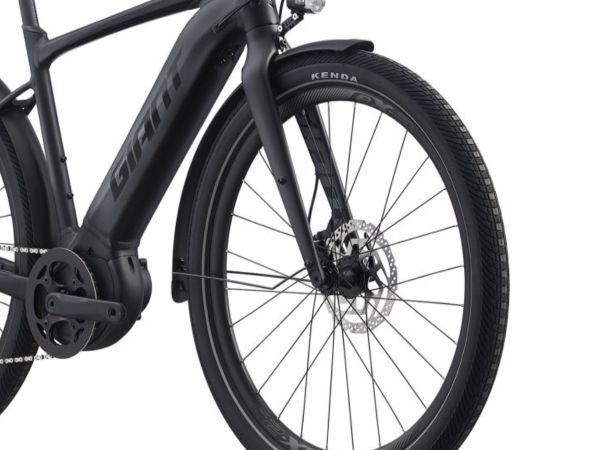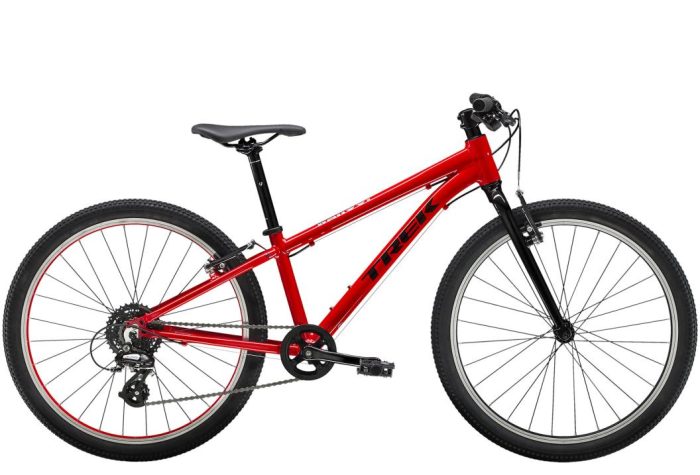Specialized Sirrus 3.0
The Specialized Sirrus 3.0 is made of ultra-lightweight aluminum alloy and carbon fibre, and it also includes dependable Shimano components that are designed to resist years of everyday usage on pavement all around the world.
Overview
| Category | Bikes |
| Brand | Specialized |
| Model | Sirrus 3.0 |
| Type | Hybrid Bike |
| Year | 2022 |
Features
Specialized Sirrus 3.0 is a more powerful version of Specialized’s workout bike with a slightly more “do-it-all” mentality. This bike is as maneuverable on back roads as it is for bombing through town or getting you to work thanks to its wide wheels and tyres and riser bar from a mountain bike. On prices, there is, nevertheless, some fierce rivalry.
The Sirrus line of bicycles are hybrids with slick tyres, a 2x chainset, and either a compact or step-through frame.
Even with the tyres pumped up firm, the ride quality isn’t horrible for what is essentially a budget aluminum alloy frame and fork. Although I found the lack of hand positions that a flat bar brings weird and something I must admit I’m not used to, it handles rough terrain nicely, and I never felt like I was being pounded.
Frame & Geometry
The fork is constructed of Carbon fibre, while the frame is built of excellent-quality Specialized A1 Premium Aluminum. The frame, on the other hand, has every feature a hybrid bike would need, including eyelets for mounting mudguards and pannier racks if desired.
In comparison to the Specialized Sirrus 2.0 model, the Carbon Fact 9 fork is more comfortable and weighs 1.2 kg less.
The geometry is fairly relaxed on a bike of this kind, which puts you in an extremely upright position. In contrast, I felt that it was a touch too relaxed, causing me to sit rigidly upright and slowing me down—not good when you’re running late for work.
Drivetrain
The Specialized Sirrus 3.0 has a 9-speed, entry-level mountain bike groupset called microSHIFT R9 that handles all of the shifting. This has an 11-34t cassette and a Forged aluminium arms, 2-piece, 24mm spindle, 46/30T crankset, which provides more than enough gearing to handle some quite steep hills on both the uphill and downhill sides.
The shifting is actually more than adequate for such a groupset. The front and rear derailleurs are both MicroSHIFT, which are incredibly dependable and precise. I rarely needed to give the thumb shifter more than a little prod to start the chain moving.
Brakes, Rims and Tires
Specialized Sirrus 3.0 comes with Tektro HD-R280, hydraulic discs. model comes with TRP Flow Set Control brakes as an option.
Except for the V-Brake, which uses 700C Rim brakes, all Specialized Sirrus models have 700C Disc rims.
The Sport and Disc models of Specialized Sirrus 3.0 comes with the the Specialized Nimbus Reflect tires
Key Features
Specialized Sirrus 3.0 performs well because the frames are lightweight, long rides don’t exhaust the rider as much. The thick tyres let them to withstand some punishment on city streets. These bikes’ flat handlebars and fitness shape make them more responsive, which is vital in the city.
Consider this Specialized Sirrus 3.0 bike model if you’re seeking for an excellent bike for exercising or commuting to work. There is a model that practically everyone can afford thanks to its reasonable price range. In addition, they are designed to be comfortable and effective for all riders, regardless of their level of experience.
Specifications
Check specifications here
| Frame | Specialized A1 Premium Aluminum, Fitness Geometry, butted tubing, internal cable routing, flat-mount disc, quick-release, Plug + Play rack/fender mounts |
| Handlebars | Double-butted alloy, 9-degree backsweep, 31.8mm |
| Stem | Specialized, 3D-forged alloy, 4-bolt, 7-degree rise |
| Tape | Specialized Body Geometry Contour, lock-on |
| Saddle | Bridge Sport, Steel rails, 155/143mm |
| SeatPost | Alloy, 12mm offset, 2-bolt clamp, 27.2mm |
| Seat Binder | Bolt-type, 31.8mm |
| Front Brake | Tektro HD-R280, hydraulic disc, resin pads, flat-mount, 160mm |
| Rear Brake | Tektro HD-R280, hydraulic disc, resin pads, flat-mount, 140mm |
| Shift Levers | microSHIFT, 9-speed |
| Front Derailleur | microSHIFT R9, 9-speed, 31.8mm clamp |
| Rear Derailleur | MicroSHIFT RD-R43M, medium cage |
| Cassette | MicroSHIFT H092, 9-speed, 11-34t |
| Crankset | Forged aluminum arms, 2-piece, 24mm spindle, 46/30T |
| Chainrings | 46/30T |
| Bottom Bracket | Shimano 68mm threaded |
| Chain | KMC X9, 9-speed w/ Missing Link™ |
| Rims | 700C disc brake, double-wall alloy, 22mm depth, 21mm internal width |
| Front Hub | Alloy, 6-bolt disc, loose ball bearing, quick-release, 32h |
| Rear Hub | Alloy, 6-bolt disc, 8-/9-speed freehub, loose ball bearing, quick-release, 32h |
| Spokes | Stainless, 14g |
| Front Tire | RoadSport Reflect, Wire bead, Blackbelt/Endurant Casing, 700x32c |
| Rear Tire | RoadSport Reflect, Wire bead, Blackbelt/Endurant Casing, 700x32c |
| Inner Tubes | Presta, 48mm valve |
| Pedals | Specialized Body Geometry Fitness, platform, plastic |
| Fork | Specialized FACT 9r Carbon, flat-mount disc, quick-release |
Video Presentation
Pros & Cons
Pros
Lightweight frame
Comfort riding position
FItness Geomtery
Affordable price range
Good responsiveness
Cons
Flat handlebars
Conclusion
4.7
Total score
Our Rating
For the money, the Specialized Sirrus 3.0 model is regarded as one of the greatest fitness hybrid bicycles available.
Because they are lightweight, they are simpler to pedal over long distances or up steep city hills. So, if you’re looking for a bike to help you get and remain in shape, a Sirrus 3.0 might be the best option.
The Specialized Sirrus 3.0 can also be utilised for informal family outings and commuting to work as a road bike. It is a durable bicycle that you can use for a number of miles without being concerned that it may break.
Test drive a Specialized Sirrus 3.0 at your nearby Specialized store to determine whether it is the right bike for you.
Frequently Asked Questions – FAQs:
Is the Specialized Sirrus a road bike?
The Sirrus bikes are some of the best hybrid road bikes available for working out, commuting to work in the city, or going to the farmer’s market on the weekend. There are 16 different types of these bikes available for both men and women, with options for carbon, alloy, or aluminium frames depending on the model.
How many gears does sirrus 2.0 have?
The Sirrus 2.0 is the second bike in the Sirrus line and has powerful hydraulic disc brakes that will help you stop in any weather along with 16 speed Shimano gears. The bike contains every mount point required for mudguards and pannier racks, and the tyres have built-in puncture protection.
Is Specialized Sirrus a hybrid bike?
The Sirrus X 4.0 from Specialized is a truly exceptional hybrid. This commuter has it all: it’s quick, smooth, and practical. Conclusion: This agile hybrid provides a comfortable ride on both pavement and gravel.
What is the difference between Trek bike and Specialized bike?
Comparatively speaking, Trek offers a bigger selection of bikes than Specialized. When you choose Specialized, you receive somewhat better parts at the basic level. Both companies provide high-end bikes that are competitive and slightly different in geometry. Both companies sell a variety of mountain bikes, including hardtails, hybrids, full suspension, and others.
Is Specialized a high end brand?
Numerous types and a wide range of motorcycles are produced by Specialized. This Californian company is primarily known for its expensive bicycles, though. Although it does provide entry-level and midrange motorcycles, that is not where the real value is.
Contact Us
If you have any suggestions or advise, please feel free to reach us via our Contact Us here.
Our articles are developed after considerable research and studies online and also including seeking informational experience based tips from professional rides. Key sources of information are interviews, google search and youtube.
LIV Alight DD Disc 2
LIV Alight DD Disc 2 is relatively affordable and comes with hydraulic disc brakes, fat 38 mm tyres, a 28 drivetrain with beginner-friendly ratios, and numerous threaded bosses to take racks and fenders. It’s a terrific place to start for a woman who wants to try cycling as a sport or a mode of transportation.
Overview
| Category | Bikes |
| Brand | Liv Cycling |
| Model | Alight DD Disc 2 |
| Type | Hybrid Bike |
| Year | 2022 |
Features
Alight is typically a step-through frame. For this specific bike, Liv’s “DD” model name designates a more conventional double-diamond frame form.
Liv Alight DD Disc 2 is a flexible flat-bar road bike that is ideal for commuting and leading an active lifestyle. It has been revamped with a quick and new aesthetic, touch points to maximize comfort, accessory mounting, and reliable components.
The 3F Design Philosophy, flat handlebars, and upright riding position make casual cruising or commuting comfortable without sacrificing performance.
Modern finishes also keep style front and centre on every ride. Additionally, it is simple to add racks and fenders because of the incorporated dropouts. This bicycle combines road bike agility with urban flare. Has integrated mounts for mudguards, a rear rack, and a kickstand. It has a Shimano Tourney/Altus hydraulic disc brake groupset. comforts by maintaining comfort with shock-absorbing grips and a saddle that relieves pressure. Moreover, provides control via strong disc brakes that operate in both dry and wet conditions.
Aluxx Aluminum Frame
With single-butted tubes and 6061 alloy, this Performance level frame material creates sturdy, lightweight framesets for a variety of bikes and riding styles.
The tube geometries on the 6061 aluminum frames have been improved, and the seatstay design has been slightly lowered. However, there is also an Alight DD Disc 2 City that comes pre-installed with fenders and a rear rack. There are numerous attachment locations for extras.
Geometry
By providing both bikes and accessories made specifically for women, Liv takes pleasure in its dedication to encouraging more women to ride bicycles. Their bikes offer alternatives for everyone from casual riders to expert cyclists, and they are specifically designed to optimize fit and function for women.
Liv Alight DD Disc 2 uses measurements of women’s bodies to determine the ideal geometry for each height and use. According to Liv, this results in a bike that fits and performs better for women.
Tires
Liv Alight DD Disc 2 comes with puncture-resistant tyres and reflective accents reduce the likelihood of annoying flats while enhancing rider safety in urban environments.
Key Features
The Liv Alight DD Disc 2 offers integrated mounts for fenders, a rear rack, and a kickstand, allowing you to personalize your accessories to create place for all of your necessities and avoid obstacles.
The Liv Alight DD Disc 2 is equipped with shock-absorbing grips, a compliant D-Fuse seatpost, and a pressure-relieving saddle because being comfortable on your everyday rides is essential.
Alight Liv DD Disc With the improved fork clearance, you can install up to a 40c tyre, enhancing traction, and the 2 strong disc brakes operate in both dry and wet conditions.
Specifications
Check specifications here
| Frame | ALUXX-Grade Aluminum |
| Fork | ALUXX-Grade Aluminum, rack mount, disc |
| Wheels | Giant GX Disc wheelset |
| Hubs | Giant GX wheelset, QR, 32h |
| Spokes | Stainless Steel, 14g |
| Tires | Giant S-X2 Puncture Protect, 700x38c |
| Bottom Bracket | Cartridge |
| Crankset | ProWheel forged alloy |
| Chainrings | 30/46 with chainguard |
| Shifters | Shimano |
| Front Derailleur | Shimano Tourney |
| Rear Derailleur | Shimano Altus |
| Cassette/Freewheel | Shimano HG31, 8-speed, 11×34 |
| Chain | KMC Z8.3 |
| Brakes | Tektro R280 hydraulic, 160mm |
| Brake Levers | Tektro R280 |
| Handlebars | Giant Sport flat, alloy, 31.8mm |
| Stem | Giant Sport |
| Seatpost | Giant Sport, 27.2 |
| Saddle | Liv Sport Comfort |
| Pedals | Giant Urban Fitness |
Pros & Cons
Pros
Amazing handling
Superb in straight trails
Lightweight bike
Versatile bike
Cons
Some may find uncomfortable seat
Conclusion
4.7
Total score
Our Rating
This bike handles like a dream and is super fast on the flat trails. It seems to have enough gears even for serious hills.
Liv Alight DD Disc 2 is shockingly lightweight, it weighs about 25 pounds, I ride is far better as compare to any other cross bike. The Liv Alight DD Disc 2 is very versatile, It has mounts for either fenders or racks. You can set up with a rear rack for a trunk that includes panniers. It can even handle your swim practice and grocery commutes with ease. The bike can also go off road with its 700x38c tires.
Liv Alight DD Disc 2 is exactly what the description above says it is. This bike proves you don’t have to spend thousands on a super light bike to get an enjoyable ride.
Frequently Asked Questions – FAQs:
Does Liv Cycling produce cycles for men?
Liv takes pride in providing bicycles specially catering the need of women.
Contact Us
If you have any suggestions or advise, please feel free to reach us via our Contact Us here.
Our articles are developed after considerable research and studies online and also including seeking informational experience based tips from professional rides. Key sources of information are interviews, google search and youtube.
Cannondale Quick CX 4 Women
A women’s urban-adventure bike for city streets and town paths is the Cannondale Quick CX 4. On a single bike that can do everything in the open countryside and wherever else, broaden your horizons.
Overview
| Category | Bikes |
| Brand | Cannondale |
| Model | Quick CX 4 Women |
| Type | Hybrid Bike |
| Year | 2022 |
Features
Cannondale Quick CX 4 is a women’s hybrid bike with a tonne of features that enable it to perform effectively in practically any setting.
Cannondale Quick CX 4 is fully comfortable. This is accomplished by Cannondale using parts including a 63mm travel Suntour NEX-E25 fork, SAVE micro-suspension technology, broad 40mm tyres, and a naturally upright riding position.
Thanks to potent Promax mechanical disc brakes and 40mm Vittoria Terreno Dry multi-surface tyres that guarantee high-level grip on and off-road the aforementioned suspension, Cannondale Quick CX 4 also performs flawlessly on light trails and inclement weather.
Numerous gearing possibilities are offered by the 3–7-speed Shimano Tourney drivetrain, and fender and rack mounts let you adapt your bike to any task.
Frame & Fork
The frame of the Cannondale Quick CX 4 is made of aluminium alloy. The lightweight, MTB-inspired Aluminium Alloy frame from Cannondale, a master of aluminium frame design, offers a comfortable upright riding position. The Smartform Alloy technology from Cannondale aids in producing fine tubing, perfectly controlled tube shapes, and robust welds to produce the essential rigidity.
Uneven surfaces are sufficiently mitigated by the Suntour NEX front suspension fork. Cycling on smooth roads is more efficient when the fork is locked out using a switch on the fork crown.
Drivetrain
A drivetrain modelled after an MTB is installed in the Quick CX 4. The hierarchy of Shimano MTB groupsets places the Shimano Altus/Acera combination in the middle. These speeds functioned without any lag throughout the test trip, and the gearboxes shifted smoothly. The 24-Speed combo provided adequate depth for both climbs and acceleration. The shifters operated smoothly and quickly.
Ride Quality
On the Cannondale Quick CX 4, Vittoria Terreno Dry 700x40c tyres are the ideal all-arounders. These 700C tyres had strategically set treads to keep you balanced and provide you with ample traction whether you are riding on dirt or commuting on level roads. The wheelset’s reduced weight made it possible for faster rolling.
The Stock Saddle’s ergonomic shape and enough cushioning ensure the rider comfortable on uneven terrain as well as smooth courses. The overall biking experience was swift and smooth.
Key Features
The front suspension and lightweight, heavy-duty SmartForm C3 alloy frame are perfectly adapted to handle multisurface riding and have the versatility to manage it all.
Strong Suntour NEX-E25 fork with 63 mm of travel helps smooth out rocky patches while maintaining precision steering with a 1-1/2 to 1-1/8 in. tapered head tube.
Engineered flex in the frame is used by SAVE micro-suspension technology to lessen vibrations and improve the uniformity of tyre contact on uneven surfaces.
3 × 7-speed Shimano shifting and strong Promax disc brakes keep you in control whether you’re heading up or down. Whether you’re riding on pavement or mud, large Vittoria 700c x 40 mm multisurface tyres offer superb on- and off-road grip. The mountain biking-inspired natural upright riding stance keeps you at ease and in control anytime you ride. Internal cable routeing with StraightShot results in clear lines and simple maintenance.
You can adjust the Quick CX for cycling in bad weather or making excursions to the store thanks to fender brackets and universal rack mounts (fenders and racks not included). Bright 360-degree reflective components help you stand out to drivers in low light.
Specifications
Check specifications here
| Best Use | Recreational Cycling |
| Frame | SmartForm C3 Alloy, flat mount disc |
| Bike Suspension | Front Suspension |
| Fork | Suntour NEX-E25, 63 mm, coil, custom crown |
| Fork Travel | 63 millimeters |
| Crankset | Prowheel, 48/38/28T |
| Bottom Bracket | Cartridge, square taper |
| Shifters | Shimano 3 x 7 |
| Front Derailleur | Shimano Tourney, 31.8 mm clamp |
| Rear Derailleur | Shimano Tourney |
| Rear Cogs | 14-34T, 7-speed |
| Number of Gears | 21 gear(s) |
| Brake Type | Mechanical Disc Brake |
| Brakes | Promax mechanical disc, 160/160 mm rotors |
| Brake Levers | Shimano ST-EF41 |
| Rims | Cannondale Disc, double wall with eyelets, 32h |
| Front Hub | Alloy, Sealed, quick-release |
| Rear Hub | Alloy, Sealed, quick-release |
| Wheel Size | 700c |
| Tires | Vittoria Terreno Dry, 700c x 40 mm, reflective strip |
| Tire Width | 40 millimeters |
| Handlebar Shape | Riser Bar |
| Handlebar | 6061 alloy, 25 mm rise, 8 deg. sweep, 6 deg. rise, 660 mm |
| Stem | 6061 alloy, 31.8 mm, 8 deg. |
| Seat Post | 6061 alloy, 27.2 x 350 mm |
| Saddle | Cannondale Fitness Ergo |
| Pedals | Cannondale Platform |
| Headset | Semi Integrated, tapered |
| Chain | KMC Z7, 7-speed |
| Weight | 31 lbs. 3.2 oz. |
| Bike Weight | Bike weight is based on median size, as sold, or the average of two median sizes. |
| Gender | Women’s |
Video Presentation
Pros & Cons
Pros
The substantial tyre clearance ensures a cushioned and comfortable ride.
Reflective highlights that are masterfully incorporated into the painting
Light and stiff for rapid acceleration
robust and economical construction
Cons
model without female-specific contact areas while being made for women.
Conclusion
4.8
Total score
Our Rating
Enjoy a little amusement on your commute. Cannondale’s Quick CX 4 seamlessly transitions from dirt trails to bike lanes since it was designed for every nook and cranny of the urban environment. With the addition of fenders, you can turn this bike into an all-season riding machine. Its comfortable shape allows you to maintain your composure in the city. With a flexible microSHIFT drivetrain, you can easily climb hills, explore trails, and find the ideal pace on your ride home.
Frequently Asked Questions – FAQs:
How much does a Cannondale Quick CX 4 weight?
Weight: 13.5 kg / 29.7 lbs – Bike and frame weights may vary in final production.
How many speeds does a Cannondale Quick 4 have?
The lightweight aluminum frame, 360-degree reflective accents, nine levels of gearing, hydraulic disc brakes, and built-in communication with the Cannondale app are the hallmarks of this Quick 4 bicycle.
What does CX means in cycling?
On challenging outdoor tracks made of grass, dirt, mud, sand, or occasionally even snow, cyclocross racing takes place. The elites exhibit the explosiveness of track sprinters and the off-road prowess of mountain bikers on bikes that don’t look out of place on the road.
Can you use a CX bike as a road bike?
A CX bike can definitely be used for road riding. Put a pair of 700×23 tyres on the factory wheelset and you’re ready to go because many of the parts are actually road parts.
Contact Us
If you have any suggestions or advise, please feel free to reach us via our Contact Us here.
Our articles are developed after considerable research and studies online and also including seeking informational experience based tips from professional rides. Key sources of information are interviews, google search and youtube.
Cannondale Quick 3
The Cannondale Quick 3 is the ideal long-distance commuter bike if you’re looking for an urban bike that can effortlessly navigate city streets, push hard on fitness rides, or transition into such a bike. A cost-effective fitness hybrid built for speed, agility, and adaptability is the Cannondale Quick 3.
Overview
| Category | Bikes |
| Brand | Cannondale |
| Model | Quick 3 |
| Type | Hybrid Bike |
| Year | 2022 |
Features
With more of an emphasis on speed and efficiency, a fitness bike like the Cannondale Quick 3 is a cross between a hybrid and a road bike. It is nevertheless built for upright urban riding. Even though it has flat bars and is plainly not intended for roadies, it definitely pulls more design cues from the best road bikes than the conventional hybrid.
The Trek FX 3 and the Specialized Sirrus 3.0 hybrids, as well as other reasonably priced hybrids, are no match for the Cannondale Quick 3. The premium Cannondale SmartForm frame with SAVE micro-suspension, the carbon fibre fork, and the wheel sensor make it stand out.
Frame & Fork
The SmartForm 6061 aluminum frames from Cannondale are expertly crafted to concentrate the material exactly where it is needed, maximizing stiffness and strength while minimizing weight. The Cannondale Quick 3 is made even more comfortable and responsive with the inclusion of a carbon fibre fork.
With a complete carbon fork to provide stiffness and efficiency to the ride while reducing total weight, the frame is made of SmartForm C3 aluminium. The Quick 3 for ladies is available in a stunning metallic emerald green, with all-black interior and exterior accents, and is simplistically attractive thanks in large part to the numerous 360-degree reflective elements incorporated into the paintwork. Reflective features in various patterns and blocked-out areas are included on the Cannondale logo, seat stays, seat post, and fork blades, which all aid to illuminate the bike in low visibility situations.
Drivetrain
In order to reduce costs while maintaining performance, Cannondale chose a mixed-brand drivetrain for this bike as opposed to a full Shimano Altus drivetrain.
Shimano Altus shifters and Acera and Altus (rear) derailleurs are included on the Cannondale Quick 3. (front). This combo is more advanced than the entry-level Tourney setup and is more than enough for the cost.
The crankset is a Prowheel 48/32T double chainring of marginally lesser quality, and it is coupled with a Sunrace 9-speed 11-34t cassette. While not particularly impressive, this is broad enough to conquer steep grades (the lowest gear has a 0.94 ratio).
Handling & Performance
You’ll be quite pleasantly surprised by the Cannondale Quick 3’s ride quality right away. With a workout bike that accelerates swiftly and provides a stiff but comfortable ride—a trademark of Cannondale, known for its aluminium frames—you can ramp up the pace when you need to without suffering unnecessarily from arm fatigue.
Due to the brand’s OutFront steering design, which marries a 55mm fork offset with a slack head tube angle of 71 degrees, the handling is incredibly responsive, and the ride feels incredibly enjoyable and zippy
Geometry
With geometry that is as near to road bike geometry as you can go, the Cannondale Quick 3 offers one of the most aggressive ride positions you’ll find on a fitness hybrid bike. The rider is further forwards than on other fitness bikes, yet the bike is still upright enough for you to be seen on busy metropolitan roads and to see what is coming up ahead.
Due to the reduced aerodynamic drag from aggressive stance, you will be more productive and swifter than on other hybrids. However, this particular ride posture might not be appealing to all bikers, so if you’re undecided, we advise taking this bike for a test ride before buying.
Brakes, Wheels and Tires
Instead of finishing the groupset with more expensive Shimano brakes, Cannondale opted to save money by using slightly less expensive Tektro brakes.
They decided on the 160/140mm Tektro HD-R280 hydraulic discs. Although a little less expensive, this well-known brand’s brakes provide reliable stopping power and longevity for a $1,000 bike.
The advantages of hydraulic disc brakes over mechanical disc and rim brakes are their unrivalled performance in slick conditions and their relative absence of maintenance requirements.
The double-wall 700c alloy rims on the Cannondale Quick 3 are the company’s own brand. While not very sturdy, this wheelset is adequate for riding in cities.
You have Schwalble’s slick Spicer tyres mounted on the rims, which are made to minimize rolling resistance and decrease the possibility of punctures using K-Guard. Tires that can withstand punctures are a great addition to a hybrid vehicle. These 35mm tyres strike a mix between speed and bump absorption.
Features & Benefits
In order to give its intended audience certain benefits connected to fitness, Cannondale Quick 3 also packs a few extra punches. The Cannondale Wheel Sensors that are included with it allow you to connect to the Cannondale app and track your ride data. Additionally, any SP-Connect compatible phone case can be secured to the Intellimount stem, making it simple for riders to attach their phone in place to form a dashboard. By combining these two functions, you can keep track of data like your speed and mileage. The Cannondale app also offers alerts when your bike needs servicing and eco reports that detail the amount of gasoline and CO2 you’ve saved by choosing to ride rather than drive.
Model Range
The women’s particular model has just minor geometry differences but the same unisex contact points, including a Cannondale Fitness Ergo Double Density saddle and Ergo Fitness Dual Density Lock-On grips. The unisex variant is larger, with a longer effective top tube length, and a higher standover. Small to 2XL are available in its size range, whereas XS to Large are available in the women’s models. The numbers for the overlapping women’s and unisex sizes differ somewhat, so make sure to check carefully for the proper fit. In general, individuals with shorter stature and reach are probably better suited for the women’s model. The unisex range may work better for you if you have a larger reach and inseam.
Specifications
Check specifications here
- Sizes: XS, S, M, L (women’s) / S, M, L, XL, XXL (unisex)
- Weight: 11.5kg (size M with pedals)
- Frame: SmartForm C3 Alloy
- Fork: Carbon
- Shifters: Shimano Altus, 9-speed
- Front derailleur: Shimano Acera
- Rear derailleur: Shimano Altus
- Crankset: Prowheel, 48/32
- Cassette: Sunrace, 11-34 9-speed
- Brakes: Tektro HD-R280 hydraulic disc, 160/140mm rotors
- Wheels: Cannondale Disc
- Tyres: Schwalbe Spicer, 700 x 35c, K-Guard, reflective strip
- Saddle: Cannondale Fitness Ergo Double Density (unisex)
- Seatpost: Cannondale 6061 Alloy
- Stem: Cannondale 3 with Intellimount
- Handlebars: Cannondale 6061 Alloy
- Extras: Cannondale Wheel Sensor
Video Presentation
Pros & Cons
Pros
Fun to ride
Cushioned and easy ride is ensured by the ample tyre clearance.
Beautifully integrated reflecting highlights in the painting
Stiff and light for quick acceleration
Sturdy construction that is cost-effective
Stem is compatible with SP-Connect for simple phone mounting.
Cons
model designed specifically for women lacks female-specific touch points.
Handlebar too wide
Conclusion
4.7
Total score
Our Rating
One of the workout bikes with the most features is the Cannondale Quick 3. The high-quality componentry is given refinement by unique innovations like a ride tracking sensor, OutFront steering geometry, SAVE micro-suspension, and 360-degree reflective characteristics.
You might pay a little bit more for a well-known brand like Cannondale than for a more obscure or smaller direct-to-consumer option. Although brand awareness contributes to some of the higher price, the Quick series as a whole benefits from its high-end models’ design and engineering know-how.
It lives true to its name, Cannondale Quick 3. Although it has an aluminum and carbon frameset, it accelerates quickly and effectively, maintains a respectable output on the road, feels quite comfortable, and is adaptable enough to satisfy a range of requirements. Urban cyclists and commuters can add mudguards and a rear rack for year-round riding with cargo, then take it on a quick weekend getaway. Many people who prefer tracking their ride statistics, configuring various features on their smartphone, which they can easily mount to the stem with an SP-Connect case, will appreciate the built-in wheel sensors and communication via the Cannondale app.
Frequently Asked Questions – FAQs:
What does a Cannondale Quick 3 weigh?
Weight: 11.1 kg / 24.6 lbs – Bike and frame weights may vary in final production.
Are Cannondale made in China?
Despite being an American company, Cannondale produces the majority of their bicycles in Southeast Asia. While some of the more basic Cannondale models are made in Vietnam, higher-end models are built and assembled in factories in Taiwan.
Are Cannondale bikes are lightweight?
The new Quick is our all-rounder, a fast, adaptable, and enjoyable bike that appeals to a wide spectrum of riders while balancing speed and comfort. lightweight, agile, strong, and cosy. Quick, a multipurpose bike.
What size Giant bike do I need for my height?
| Conventional Size (Equiv) | Sizing | Rider Height | Rider Height (cm) |
|---|---|---|---|
| 49-51cm | XS | 5′ 2″ – 5′ 4″ | 157 – 163 |
| 51-54cm | S | 5′ 4″ – 5′ 7″ | 163 – 170 |
| 55-57cm | M | 5′ 7″ – 5’10” | 170 – 178 |
| 57-59cm | M/L | 5′ 10″ – 6′ 0″ | 178 – 183 |
| 58-60cm | L | 6′ 0″ – 6′ 3″ | 183 – 191 |
| 61-63cm | XL | 6′ 3″ – 6′ 6″ | 191 – 198 |
Contact Us
If you have any suggestions or advise, please feel free to reach us via our Contact Us here.
Our articles are developed after considerable research and studies online and also including seeking informational experience based tips from professional rides. Key sources of information are interviews, google search and youtube.
Ultimate Electric Bikes Buyer’s Guide
Table of Content here
- Electric Bike Features
- What are electric bikes?
- How do e-bike function?
- Who are the target audience for e-bikes?
- Learning About the Three Types of Electric Bikes
- How to choose an e-bike?
- E-Bike Classifications
- Understanding e-Bike Components:
- 10 Tips to find a right e-Bike:
- How to Buy an E-Bike
- Battery types used in Electronic Bikes?
- How do you run an electric bike?
- Other essential E-bike Features and parts include:
- Must have accessories for a rider:
- Safe Cycling Common FAQs
Riding an electric bike—or e-bike—for the first time can want to discover a superpower. That’s because pedal-assist e-bikes extend your two-wheel possibilities: You can keep up in stop-and-start traffic, more easily haul kids or cargo, arrive less sweaty at your destination, or simply enjoy a little extra oomph on rides that otherwise might have seemed too far or too hilly.
E-bikes initially break down into the same categories as conventional bikes: mountain and road, plus niches like urban, hybrid, cruiser, cargo and folding bikes.
Electric Bike Features
The fastest-growing segment of the bicycle market is e-bikes. However, there is still a great deal of uncertainty about who they are, what they can do, and the laws that govern them. This Electric Bikes Buyer’s Guide will answer many of your questions and show you some of the great models that we carry if you’re thinking about buying an electric bike or if you just want to read up on the facts.
What are electric bikes?
We want to clear up any confusion you may have about what exactly electric bikes are, whether you’re just doing research or trying to decide if an e-bike is right for you. The special bicycles known as “electric bikes” are equipped with a motor and battery that work together to give riders an added boost while they pedal. E-bikes come in a variety of styles or classes.
Many people don’t yet realize that electric bicycles are the way of the future for most cyclists! If you are reading this Electric Bikes Buyer’s Guide, it means that you have already conclude that using an electric assist on your bicycle will somehow “improve” your riding experience. A real treat awaits you!
E-bikes energize your ride and transform lives! The Revolution is here!
These technological marvels resemble your favorite two-wheelers and come with electric motors that are powered entirely or in part by batteries. Because they are quiet, non-polluting, and can increase cycling enjoyment for a larger population, e-bikes, as they are commonly known, are popular.
How do e-bike function?
E-bikes, also referred to as pedelecs, are pedal-powered bicycles that have an electric motor and battery installed. This adds aid, reduces effort, and in many cases speeds up your trip.
The e-bikes we sell, as we already mentioned, are propelled by a battery and motor that give riders a boost as they pedal. Since the motor is only activated when you press the pedals, this process is known as pedal-assist. Once activated, the motor uses battery power to gradually increase speed and torque so that you can ride farther, faster, and up more hills. These electric bikes typically have a number of modes that offer various degrees of aid, allowing you to select how much help you need and how quickly you want to go up to a set speed limit. This makes it possible for riders to receive aid when they need it, such as when they need to climb a steep hill or get to the office on time.
And don’t worry, even if the battery dies, these e-bikes will still function. You can pedal and change gears just like you would on a regular bike, even if you decide to ride far enough to deplete your battery. Fortunately, that almost never happens because modern e-bikes with strong batteries allow riders to travel up to 80 miles (or more) on a single charge. With charging times ranging from 2 to 5 hours, it’s simple to always have enough juice. That range is more than enough to get to work and back or take a serious joyride.
In the UK, e-bikes must abide by strict regulations. The motor can only supply a maximum of 250W of added aid up to a top speed of 25km/h (15.5mph), at which point it shuts off. The bike must be pedal powered. For comparison, that’s roughly equivalent to the amount that a fit club cyclist could produce by pedaling as hard as they could for an hour.
Who are the target audience for e-bikes?
Briefly, everyone can ride an e-bike. Around the world, electric bikes are encouraging more people to ride bicycles, and over time, various models have been created for a variety of riding categories. You might love what e-bikes can do if you enjoy riding.
There are e-bikes that make it simpler for people who want to drive less and start riding their bikes to work.
E-bikes are available for people who want to get fit and exercise more often but need a little aid to get going.
E-bikes are available for potential riders with strength and mobility issues who find it painful or challenging to ride traditional bikes.
There are e-bikes available for experienced road and mountain bike riders who simply want to ride farther and longer while having a wonderful time.
There is an e-bike you’ll love if you’ve ever wanted to ride more. Explore this Electric Bikes Buyer’s Guide to learn more details, gain insightful knowledge, and see some of the best e-bikes on the market right now.
Learning About the Three Types of Electric Bikes
Electric bikes come in a variety of designs to accommodate various uses, from navigating challenging mountain trails to getting to and from work. Regarding their electric propulsion systems, there are three broad categories. Whether using input from the rider’s pedals or from a thumb or twist-grip-activated throttle, each type applies electric power to the bicycle’s driven wheel in a distinctive way. Depending on how you intend to use the bike and how far you want to go, you should choose the one that is best for you.
Class 1: Only when you pedal does the motor start to work; it stops at 20 mph.
Class 2: Class 2 has a pedal-assist mode that goes up to 20 mph as well as a mode that only uses the throttle.
Class 3: Pedal-assist only (just like class 1), but assistance lasts until you reach 28 mph.
Class 1: E-Bike: Pedal Assist
An electric bicycle with Pedal Assist requires you to pedal to activate the motor. It is exactly like a traditional bicycle, with the exception that a motor senses when you are pedaling and engages to aid the pedaling effort. You feel as though you always have the strongest wind at your back. The throttle on this class/type of E-bike may or may not be present.
Most new riders begin with a class 1 e-bike. The most affordable and widely regarded class of bikes in terms of regulations are class 1 bikes. One can be ridden on many bike paths as well as city streets. Though access is not universal, always double-check. This class of e-bikes is starting to be accepted on conventional mountain-bike trails.
Class 2: E-Bike: Throttle Only
An electric bicycle called Throttle Only has a motor that is managed by a throttle. You don’t need to pedal on these electric bikes to take advantage of the motor. Simply turn the throttle up when you need more power, and off you go. In the middle of a corner, you’ll be able to accelerate, increasing traction. Of course, the battery will discharge faster the less you pedal.
Typically, class 2 e-bikes are allowed in the same areas as class 1 e-bikes. That’s because the motor assistance top speed for both classes is 20 mph. This article will concentrate on class 1 and class 3 bikes since REI does not sell class 2 bikes
Class 3: E-Bike: Pedal Assist 28mph
With a top speed of 28 mph, this Class/Type is the fastest “legal” electric bicycle. It is still regarded as a “bicycle” and does not need a license plate or a driver’s license, etc. It’s regarded as a bicycle by law, and man is it entertaining! A helmet is required by law. Usually, a commuter on a bicycle would receive help from this category.
Commuting and errand running are popular uses for class 3 e-bikes. They are quicker and more potent than class 1 bikes (and cost more). You’ll benefit from improved performance by being able to keep up with traffic. They can also carry heavier loads and climb better. The trade-off is being unable to use most mountain bike trail systems or bike paths.
Before selecting a specific e-bike class, research the access regulations. All the access data comes with the warning that laws, licensing, registration, age restrictions, and land-management guidelines are subject to change. Visit People for Bikes’ state-by-state guide to e-bike regulations across the nation for a state-by-state overview of e-bike laws. Additionally, confirm your plans to ride with regional municipalities and land managers.
How to choose an e-bike?
E-Bike Batteries, Riding Ranges and Motors
The power source in each bike receives a lot of attention from the manufacturers. Performance and riding range are the design trade-offs. A more potent motor produces more torque for hauling cargo and climbing hills, as well as more speed for keeping up with traffic. Additionally, a more potent motor uses the battery more quickly, reducing your riding distance.
You can compare potential e-bikes based on their broad riding-range specifications, such as 20–100 miles of pedal assistance. This is so because a wide range of factors affect riding range.
Of course, having a large battery is helpful: Watt hours (Wh), which represent the number of hours a battery can store 1 watt of power, are used to measure capacities. Motor power is therefore important: A typical class 3 bike configuration uses a 500-watt motor and a 500-Wh battery, which uses power more quickly than a 250-watt motor and a 500-Wh battery (a common class 1 bike setup).
Bosch’s E-Bike Range Assistant is an intriguing online tool that illustrates how a variety of factors interact to affect riding range. It matters where and how you ride, too: Read Introduction to Electric Bikes i.e., e-Bikes to learn some advice on how to increase your range.
Battery charge time:
Time needed to fully charge a battery from empty. Most batteries take three to five hours, though larger-capacity batteries may take longer. If you intend to use your e-bike for commuting, you can buy extra chargers or bring your charger with you. Also available are quicker chargers.
Number of batteries:
Some electric bikes let riders use two batteries simultaneously. This may lengthen your trip; additionally, you have a backup battery in case the primary one dies. Additionally, you can buy an extra battery to keep one that is fully charged on hand or replace your current one when it runs out of power (typically several thousand charges).
Battery mounting setup:
Space for bottle cages or a small bike bag is made available by batteries built into the frame. However, external batteries are simpler to recharge and swap out.
E-Bike Place of Motor:
On the bottom bracket are mid-drive motors (the place where the crank arms attach to the bike frame). Located inside the hub of the rear wheel are hub-drive motors (some are on the front wheel).
Which motor should I buy?
Since e-bike motor technology has advanced so quickly in recent years, it has been challenging to decide the best model—until now, that is! You’ll be glad to know that the e-bike market has now identified the direction of travel. When buying an e-bike, only two motor types should be considered. Both motor types are incredibly dependable, energy-efficient, and the E-Bike industry’s future.
Mid Drive / Center Drive Motors:
For a variety of reasons, this configuration is found in many motors. The motor’s weight is centered and low, which helps to keep the ride stable and in balance, and the pedal assist responds with a natural feel.
The most effective motors usually have the greatest range are mid drive/center drive motors. All uses, including hills, speed, distance, commuting, exercise, and fun, are excellent for them. These motors offer much better center of gravity and lighter weight, which improves the way the bike handles. A Mid Drive / Center Drive Motor’s potential higher cost compared to a Hub Drive Motor is its only drawback. But if you can afford it, it’s well worth the added cost.
Hub Drive / Rear Hub Drive Motors:
You feel as though you are being pushed along when using rear-wheel hub-drive motors because pedal force goes directly to the back wheel. It should be noted that changing a flat on a wheel with a hub drive mounted can be trickier than doing so on a standard (or mid-drive) bicycle. Front-hub drive motors allow a standard bike drivetrain to be used on the back of the bike and handle somewhat like front-wheel drive cars.
Rear hub drive motors come in two different varieties.
- Direct Drive: Best for flat, fast commutes; works well for most hills (but not “steep” hills); great for transportation; and fun.
- Geared Hub: Ideal for climbing steep hills and carrying heavy loads! however, are excellent for all applications, including commuting, exercise, and leisure. If the battery dies, this motor pedals effectively.
E-bike Motor Torque
If you intend to ride up many hills and/or haul heavy loads, torque is a specification to look for. The stated maximum for an e-bike may range from 40 N m to 80 N m in newton meters (N m). As you adjust the pedal-assist settings, though, your actual riding torque will change.
E-Bike Classifications
Electric bikes are available in a range of styles to suit a range of uses, from negotiating treacherous mountain trails to getting to and from work. There are three major categories when it comes to their electric propulsion systems. Each type applies electric power to the bicycle’s driven wheel in a unique way, whether it is done so using input from the rider’s pedals or from a thumb or twist-grip-activated throttle. You should select the bike that is best for you based on how you plan to use it and how far you want to travel.
Class 1: The motor only activates when you pedal; it shuts off at 20 mph.
Class 2: Class 2 has a throttle-only mode and a pedal-assist mode, the latter of which can reach 20 mph.
Class 3: Only pedal aid (like class 1), but aid is supplied up to a speed of 28 mph.
Read Introduction to Electric Bikes i.e., e-Bikes
Commuter Bikes
The purpose of commuter bikes is to supply practical transportation. They come in a variety of designs, such as those with straight handlebars and narrow tyres, others with wider tyres and thicker frames, and folding e-bikes that are simpler to store on a bus or train. For many people, electric bikes are a much more affordable choice than gas-powered scooters or even a car. Thanks to the electric assist, many people find that they can commute on an e-bike without getting too hot on the way to work and that they are less likely to get caught in snarling traffic.
Pros: These e-bikes can be customized with fenders, lights, and other accessories to make them a practical substitute for a car for errands around town and commuting to work. They were created with comfort and adaptability in mind.
Cons: Commuter bikes typically weigh a little bit more than some types of recreational models because of their more robust construction designed to withstand the abuse of daily use, especially when an electric motor and battery are added.
Cruisers Bikes
The lightweight frame, narrow tyres, and drop-down handlebars of road bikes typically aid in the rider’s ability to keep an aerodynamic position. Electric road bikes have components that are lighter and slimmer than those on their pedal-powered counterparts, which increases efficiency. With less effort than with conventional bicycles, an electric motor’s aid makes it possible to travel farther and climb steeper inclines.
Pros: These bikes are quick and light, making it easy for them to travel farther distances. In comparison to a traditional road bike, you can travel further or climb steeper hills while still getting a workout thanks to the electric motor and battery.
Cons: These models are often expensive, and some riders may find the aggressive riding position uncomfortable.
Electric Road Bikes
The lightweight frame, narrow tyres, and drop-down handlebars of road bikes typically aid in the rider’s ability to keep an aerodynamic position. Electric road bikes have components that are lighter and slimmer than those on their pedal-powered counterparts, which increases efficiency. With less effort than with conventional bicycles, an electric motor’s aid makes it possible to travel farther and climb steeper inclines.
Pros: These bikes are quick and light, making it easy for them to travel farther distances. In comparison to a traditional road bike, you can travel further or climb steeper hills while still getting a workout thanks to the electric motor and battery.
Cons: These models are often expensive, and some riders may find the aggressive riding position uncomfortable.
Electric Mountain Bikes
Mountain bikes are designed to handle trails, big rocks, logs, and other challenging terrain and obstacles. They have stronger frames, larger tyres, and—in some cases—long-travel suspension components. Mountain biking is fun because it allows you to experience faster, easier downhill thrill rides, but getting there usually requires you to pedal up difficult grades on unstable ground. A mountain bike with an electric motor makes a lot of sense for someone who wants the fun without the exhaustion.
Pros: Riders who use electric mountain bikes can speed up the ascents and make the most of their time on the trails. They can also make mountain biking more accessible to those who might not be physically fit enough to handle the more taxing aspects of off-road riding.
Cons: Mountain bikes with traditional pedal power are now more widely accepted, but some trails may not allow electric bikes. Before you buy one, make sure to check the state and local laws.
Electronic Cargo Bikes
Cargo bikes are the industrial beasts of the two-wheeled world thanks to their strong frames, fat tyres, and durable components. They are designed specifically to transport large objects and added passengers. Electric cargo bikes make it even simpler to transport a lot of weight on two wheels than the pedal-powered models, which have been around for a while. Like their pedal-only forebears, cargo e-bikes can be equipped with front-end cargo boxes supported by one or two wheels, rear-mounted seats or cargo racks, or both. This category can also include bicycle taxis; the two-wheeled models are common for urban delivery and kid transportation.
Pros: Electric propulsion can be a notable change for anyone who wants to use a bicycle as an alternative to a car, such as to run errands and carry heavy loads of groceries, packages, or passengers. Adding more weight to anything makes it more difficult to move around.
Cons: Compared to most other bicycle types, cargo bikes are bigger and heavier. When a battery and an electric motor are added, their weight increases even further.
Electric Hybrid Bikes
Hybrids are ideal for people looking for a flat-handlebar e-bike they can use for anything from a commute to a family outing in the country. They are made to be the versatile e-bike you can use for a variety of surfaces (roads or rougher paths). Some hybrid e-bikes are better suited for riding on the road, while others have wider tyres and front suspension that make them better suited for off-road trails.
Electric Folding Bikes
For those who need to take their e-bike on public transportation, want to neatly store it away at home, or want to store it under a desk at work, folding e-bikes offer specially designed motor systems to fit within smaller, lighter frames. Although these motor systems are sometimes less powerful, they offer a great alternative.
Understanding e-Bike Components:
Frame style
The widest selection of frame designs is typically found on hybrid e-bikes. There are various step-through frames in addition to standard crossbar frames. It is much simpler to mount the bike thanks to their dipping top tubes or absence of top tubes altogether. A step-through e-bike makes life much simpler if you’re carrying loads in the back, have a child seat installed, or find it difficult to raise your leg to the horizontal position.
Depending on how low the frame dips, step-through frames can be referred to as a “mid,” “open,” “trapeze,” or even a “low step.” The riding position on step-through bikes is often much more upright and comfortable.
Motor types – Frame and hub
The two main types of e-bike motors are those that are attached to the hub of a wheel or the bottom bracket area of the frame, which is where the pedals and crank arms revolve. There isn’t a standout that stands out as the best; rather, each has pros and cons of its own, but they all work well.
The intensity of each pedal stroke can be directly measured by a centrally or on the frame mounted motor. As a result, depending on how much effort you put in yourself and the aid setting you choose (more on that later in “Modes”), it can offer a specific amount of added aid.
Due to the increased stress placed on the drivetrain, especially for the very high-powered models, they may need more maintenance than hub motor systems.
Your effort is transmitted to the rear wheel by the pedal action, where it is detected by sensors and aided by a hub motor mounted there. These motor types are particularly popular on road e-bikes and fashionable city e-bikes because of their lighter weight and svelte design.
Since the middle part of the bike frame does not need to be engineered around a rear hub motor like a frame-mounted motor does, an e-bike can also be designed with a rear hub motor at a lower cost. This often results in lower manufacturing costs, which improves value for the rider.
Additionally, most a rider’s weight pushes through the rear wheel, adding traction, which can be helpful in more slick conditions, and the rear structure of a bike frame is typically the strongest.
Front hub motors are unique in that they depend on being “pushed” to turn on and add their own aid. This is because they are not directly connected to the pedaling drivetrain. It can sometimes appear as though they are pulling the bike as you pedal because of this. Cheaper e-bikes are more often equipped with this type of motor.
Gear systems
Derailleur or hub-based gear systems are two options for e-bikes. Although derailleur systems are much more prevalent, each has advantages and disadvantages.
Most of us are accustomed to seeing a derailleur gear system on a typical bike. This is where you physically shift the chain to a lower or higher gear by using a derailleur. Everything is concealed and the gears are chosen internally in a hub gear system.
In real life, derailleur systems are simpler to fix if something goes wrong and can supply more gearing options. Since hub gears are shielded from the elements, they need less maintenance and generally last longer.
Drivetrain
The drivetrain of an e-bike consists of the components that push and pull you sends. This means a chain, cogs, and, as was mentioned above, possibly a derailleur that may or may not help you change gear for many e-bikes.
A belt drive system is an alternative to a chain drive system, which can easily become dirty and then contaminate your clothing. There may be one or more gear systems involved, but no derailleur.
If bike DIY is not your thing, a belt drive is an exceptionally clean and minimal maintenance system since there is no chain to oil and you can ride for 500 miles before it even needs tightening!
Batteries
As battery technology advances quickly, some manufacturers have been able to shrink their batteries to the point where they can clip into a frame cavity or fit inside the frame itself. Others, meanwhile, are maximizing the power of the tried-and-true exterior battery design.
The size of a battery is largely determined by its intended use; for enthusiasts like road and mountain bike riders, a smaller battery that has been fully or partially integrated into the frame is frequently preferred for performance and aesthetic reasons. Urban commuters might benefit more from a larger, more practical design that mounts outside the frame or as is often the case, into custom pannier racks (these are often cheaper to produce too, without compromising quality).
The ability to remove a battery can enhance your e-security bike’s when parked and make charging simpler and more convenient. Additionally, a removable battery is necessary if you can only store your e-bike in an area without access to electricity.
Although there may be variations on this theme, battery ability and charging speed should be your top priorities. A battery with a higher capacity or one that charges quickly (or an e-bike with swappable or extendable battery packs) will be appealing if you often travel longer distances or if you expect needing to rely more heavily on pedal aid because you live in a hilly area.
Amp hours are the standard unit used to measure battery ability, the higher the number, the greater the battery’s ability and potential range.
Note: In extremely cold temperatures and with use, battery abilities degrade (although lithium-ion battery technology, on which most e-bike batteries are based, is constantly improving to mitigate this). Buy batteries with a warranty from reputable manufacturers.
Systems with motors and batteries work together. This market is shared by well-known and well-respected manufacturers from the cycling and electronics industries, who occasionally work together to create new systems. In addition to more well-known names like Bosch, Sony, and Yamaha, these brands also include specialized names like Shimano, Ebikemotion, and Fazua. Once you’ve selected your e-bike, keep in mind that electronics and built-in frame mountings for electronic parts are very rarely cross-compatible, so you’ll need to stick with your system.
Mode
There are typically several power settings available for e-bike motor systems. Although this varies between motor systems and models, these can be arbitrarily set to low, medium, high, plus some sort of “max” setting. While others might have five or more, some may only have two settings.
Ultimately, we don’t believe that the variety of modes should worry you too much; as long as a control interface makes it simple to switch between modes while you’re on the go, you can pick and choose the modes you need.
Knowing what functions best for you daily is best learned through experience; many people even discover that they rarely need to use their e-“max” bike’s setting, instead preferring to use a lower power mode.
An e-bike should have a handlebar-mounted control unit or, in some cases, a frame-mounted control unit. However, some models come with smartphone apps that can perform system diagnostics and firmware updates and supply metrics such as mileage, use, and even tips on how to improve range. This control unit (and app) will also show you how much battery life you currently have, while some can dynamically estimate your remaining range.
Range
The claimed ranges by manufacturers should be taken with a grain of salt because, like how you drive your car, the range of an e-bike depends on how you ride it. If you ride it constantly in its most powerful mode, the battery will be depleted much more quickly. Depending on the mode you have it set to, hilly terrain may also cause the motor to supply more aid more often.
Some systems offer companion apps that, as we’ve already mentioned, can help you learn how to get the most range. But in the end, your potential range can be calculated using just three variables: the battery capacity, the motor’s power output, and how you ride it.
Weight
The fact that e-bikes are heavier than regular bicycles due to the motor, battery, and electronics is one of their few drawbacks. It follows that while it is possible to ride them without the motor system, it is more challenging than it would be without those components.
E-bikes can weigh anywhere from 10 to 11 kilograms (for a high-end, specialized road e-bike) to 25 kilograms (for large hybrid e-bikes). This makes it difficult to transport them in the latter scenario, such as onto trains. Nevertheless, extra weight and “sturdiness” can help drivers more easily negotiate potholes and uneven road surfaces. Due to their collapsible design and lighter weight, foldable e-bikes stand out because they are intended to be portable. One such example is the Brompton Electric folding bike (around 16-17kg with the battery attached). For longer journeys, the ride quality is generally less comfortable due to the smaller wheels and design.
There are also full-size e-bikes available, like the Pure Flux One, with competitively low total weights and no disadvantages of having small wheels. View the Pure Flux One right away.
Build quality and reliability
E-bikes can generally be counted on to provide good standards of build quality (as long as they comply with these regulations!), reliability, and longevity because they are more established than e-scooters and have more regulations and standards that underpin overall designs.
There are some traps, though, that you should be aware of and avoid.
E-bikes can be found for a bargain price and with claims of the same (or even “derestricted”) performance all over online shopping sites like eBay. These should be avoided because the manufacturers may not be manufacturing or obtaining their frames and components from reliable sources, and any warranties supplied are probably, at best, minimal.
Unbranded motors and batteries should also be avoided, as well as unbranded e-bikes. All e-bikes should be able to be ridden in the rain without any problems, but cheap electronics can, for obvious reasons, be at best unreliable and, at worst, dangerous.
You might also be persuaded to buy used items. Even though used e-bikes have their uses, you run the risk of buying an e-bike with unrecognized, impossible-to-diagnose problems (like a deteriorated battery and/or faulty motor, plus worn-out mechanical parts) that are no longer covered by warranty and require replacement.
Cost and value
E-bikes typically cost more than a comparable-equipped conventional bike, primarily because of the inclusion and expense of the motor systems and electronics.
This cost will largely change as a result of a few things, mainly because of Mechanical components (the non-motorized parts), Battery capacity (plus addition of an extra battery), Motor specification, Reputation of E-bike Manufacturer, and Frame Material.
Despite the fact that e-bikes can cost several thousand pounds, it’s important to compare the price of an e-bike to the cost of your current commute or travel habits. Do you already spend a substantial part of that money annually on things like parking fees, fuel, and congestion for your car?
An e-bike can often be found to be significantly less expensive than other motorized transportation over a period of as little as a year, while there are also numerous advantages to being outside in the fresh air and still being relatively active.
10 Tips to find a right e-Bike:
If only selecting an electric bike to buy was as simple as pedaling up a challenging hill on one. Here are ten suggestions to help you decide what to do and get riding.
1. Think About Your Needs
Different people and purposes call for several types of electric bikes. You must decide which features are most crucial. A step-through frame might be the best choice if comfort is important. A middle motor system or high torque hub motor may be the best option if hill climbing is essential. If you enjoy riding long distances, a battery with 400 watt-hours or more is the best option. You can choose the features on your electric bike that are most important to you by being aware of your individual needs.
2. Select Your Retailer Carefully
An electric bike purchase should be as much an investment in a bike shop as it is in the actual product. Three criteria should be used to evaluate your place of purchase: atmosphere, dedication, and quality. The vibe is the impression you have of a place when you enter it. Is the staff accommodating, knowledgeable, and supportive? The shop’s commitment to electric bikes can be seen in their obvious enthusiasm. Do they have a lot of e-bikes or are there only a few stuck in the shop’s back room? Given their dedication to the electric bicycle movement, the shop will be ready and eager to aid you in getting the most out of your electric bike for many years to come. The types of bicycles that the retailer sells are of high quality. Are they bicycles with well-known brands about which you can do some research, or are they obscure models? To ensure that your retailer is working for the right reasons and not just to make a quick profit, check their motives.
3. Test Drive A Few Bikes.
The test ride is arguably the most significant—and enjoyable—step in purchasing an electric bike. When you test out an electric bike, you can ignore technical details, expert opinions, and research in favor of the simplest question: “Do I love this bike?” If the answer to the first question is affirmative, move on to the following queries: “Does it climb hills in the way I need it to? Does the bike fit me in the way I would like it to? Does it have the quality and functionality I would like?”
4. Set High Expectations
One of the most innovative modes of transportation is the electric bike. Finally, high-quality electric bikes that are dependable, powerful, practical, and enjoyable to ride are available. An electric bike can essentially change your life. Nevertheless, not all electric bicycles are made equally. Many electric bikes on the market today fall far short of the ideal of a contemporary, high-quality machine. It is up to you, the customer, to demand the best and have ambitious standards.
5. The Warranty Matters
Purchasing an electric bike, whether it costs $1500 or $10000, is a significant financial commitment. You can be sure that your investment is worthwhile with a warranty. It is reasonable to expect most electric bike manufacturers whose products sell for more than $2000 to offer a two-year warranty on parts, motor, and battery (with no exclusions for normal use).
6. Believe In Your Instinct
There may seem to be an information jungle out there, and that is not far from the truth. There are lots of options and viewpoints, but there are few reliable organizations that systematically certify and evaluate electric bikes. What should a person do? Trusting your instincts is the best course of action. Anything that seems too good to be true probably is. It is probably best to avoid a bike if it is from a brand, you have never heard of, and you can’t find any information about it.
7. Look At The Long Term
Being environmentally sustainable involves more than just using electricity; it also involves how the bike was made, how well it was made, and how well it was supported after the sale. With regular maintenance, your bike should last at least five to ten years, and your battery should last between 600 and 800 full charge cycles. And when a new battery is needed, your retailer should be prepared to have the old one recycled or rebuilt rather than thrown away.
8. Quality Counts But Service Counts Just As Much
Electric bikes serve as transportation, not as toys. Regardless of the drive system, the bicycle’s quality is crucial, and it’s even more crucial if you intend to ride it every day. Motors and batteries can be a little trickier to evaluate in terms of quality than bicycle components, which can be easily done by reading the list of parts. When in doubt, investigate the brands of the motor and battery. But keep in mind that if your electric bike is not set up and tuned properly, it won’t make much of a difference how high-quality the components are. Your neighborhood independent bike shop is a valuable resource for supporting the high-quality parts you bought.
9. Buy Locally.
Buy locally whenever you can. Even if everything goes perfectly, you will have questions about your bike and, in the worst case, problems. For this reason, you should always be within 50 miles of your place of purchase so that they can assist you. Additionally, your purchases guarantee that you will have access to local electric bike specialists for years to come.
10. You Get What You Pay For
The proverb applies to electric bikes just as much as it does to everything else in life. The cost of creating a good electric bike with high-quality parts is not low. Expect to pay at least $1500 for bikes with a cadence sensor or a throttle. Budget $2500 and up for electric bikes with torque sensors. The good news is that a high-quality e-bike can quickly pay for itself. And the happiness dividend is not even taken into consideration!
How to Buy an E-Bike
Find a model that physically complements you and will also serve your long-term needs by taking your time. If you live in a hilly area, you may want to choose a model with more gear options to conserve energy—both your own and the battery’s. To find out what, if anything, is necessary to ride an e-bike in your community and where you are allowed to do so, consult local regulations.
New companies like Rad Power Bikes and Blix Electric Bikes that specialize in making e-bikes are available. Although you might not be familiar with them, some of these more recent businesses have successful operations, innovative products, and excellent customer service. However, be wary of online bike brands that might not be around to supply customer support the following day. If you don’t stick with the reputable names like Cannondale, Specialized, and Trek, diligence is required.
Salespeople who specialize in bicycles are rare. This may affect assembly and repairs, and you might end up having to spend any money you had saved on trying to fix a cheap bike—or later upgrading—to get it to function properly. Due to the subpar quality, many smaller bike shops won’t even offer maintenance for models purchased from big-box stores.
Another choice is to buy a bike from a direct-to-consumer manufacturer, but this will likely require some final assembly, such as attaching the handlebars, seat post, and pedals. You’ll need some mechanical know-how and perhaps even specialized tools like hex wrenches or torque wrenches. You can bring the bike to a nearby shop for assembly, but there will be a fee.
Nevertheless, a lot of neighborhood bike shops now offer e-bikes for sale, and the sales and service staff are often deeply knowledgeable about them. When you decide you want to buy one, they can also aid you in making a wise decision.
We always recommend riding a bike before buying it. Get a feel for the bike’s handling, braking, and shifting. (A dealer can make it fit specifically for you.) Additionally, some retailers will let you rent an e-bike, giving you the opportunity for a longer ride on the road or trail you intend to often use. Even if it’s not an exact replica of the model you want to buy, renting would give you more time to decide which e-bike design suits you the best.
Remember that the model you’ve chosen can be—and should be—further customized after you’ve made your choice. Your points of contact and control are the handlebar tape or grips, the pedals, and especially the saddle. All the components of the bike can be changed to fit you; for example, a new stem can be used to move the handlebars closer to your torso. Your hands, feet, and butt must all rest comfortably. A dealer can also add accessories for you, such as a bell, lights, fenders, or a luggage rack, which might not be included with a bike. But getting the fit right is crucial.
You might experience sticker shock if you haven’t recently bought a new bicycle. Bicycles, and electric bikes, can be rather expensive. There are options for “buy now, pay later,” and each one is set up differently. Affirm, a sizable financial institution, offers some options with interest rates of 0%, but it also has the option of charging rates of 10% to 30%. A comparable rival, Klarna, is more likely to provide a “pay in four” plan with 0% interest for a four-month loan.
How do these banks profit from offering loans with no interest?
The reason retailers and manufacturers of exercise bikes, like Peloton, which offers zero-interest loans through Affirm, front the finance charges, is that moving inventory is more important to them than earning a few extra dollars from financing.
Cautionary Advice: Before enrolling in any buy now, pay later plan, consider the potential for high interest rates.
Be Sure You Get a Good Fit on Your E-bike
The best bike for you is one that fits you, and this is true for both conventional bikes and e-bikes. Before you ride an e-bike out the door, it’s important to make sure it feels like it was made for you or can at least be adjusted to fit you with a few clever parts swaps.
Knowing which size bike frame you need, roughly based on your height, is essential for getting a good fit. Beyond frame size, the geometry of an e-bike will decide how it should fit your body measurements. The best way to fine-tune your fit so that your knees, shoulders, back, feet, and hands are all correctly aligned for the riding position you need is to go to a bike shop. Additionally, you can get a thorough bike fit from a fit specialist, which can help you perform at your peak and prevent chronic injury. Learn more about fitting your bike in our article.
Try out the bike you want while you’re at the bike shop. Customers can do this in most stores. You’ll get a better sense of your options and be able to determine which style is best for you by trying out multiple bikes.
Battery types used in Electronic Bikes?
The Battery
Sealed Lead Acid (SLA) or Lithium batteries are used in most electric bikes that you will find on the market. Your choice of battery type will have a significant impact on the weight, style, and range of your electric bicycle, so make sure you make the right choice for you.
Sealed Lead Acid (SLA)
This battery has been the industry standard for electric scooters and bicycles for many years. While electric bicycles have switched to a newer battery technology that often requires human intervention but is much smaller and lighter, electric scooters still use SLA batteries.
SLA Advantages
More affordable
SLA Disadvantages
Large and heavy compared to more recent battery technology.
Shorter riding range.
Lower life expectancy (roughly 100-300 full charges).
Immediate recharging after use.
More expensive to keep.
Lithium Ion
The lithium-Ion battery is the most recent in battery technology, with a life expectancy that is two to three times that of a SLA battery. Electric bicycles are a perfect fit for this material because of its longer life, lighter weight, and reputation for minimal maintenance.
Lithium-Ion Advantages
increased lifespan Up to 800 charges per day for up to three years.
Up to a 20-mile range on the throttle alone or a 40-mile range with pedal aid.
Lightweight batteries
Lithium-Ion Disadvantages
• More expensive
The Controller
The bike’s controller is a crucial part for the bike to run properly. There are two main types, and they are typically mounted on the handlebars.
Pedal-activated controllers
• Throttle-based controllers
Pedal-activated electric bikes automatically start the motor when you pedal, ending the need for a throttle. You can choose the level of aid you want for your ride using the controller, which is mounted on the handlebar. There are various levels of aid, from almost none to a lot.
An electric bike with a throttle uses a straightforward mechanism to help move the bike forwards. Typically, the mechanism is either a twist-grip or a thumb-press. With many throttle-controlled electric bikes, you can ride on the throttle alone even though it is intended to help with pedaling. No peddling is necessary.
The fact stays that electric bikes are low-maintenance, simple to run, and enjoyable to ride.
How do you run an electric bike?
Electric bikes are amazingly simple to use. Three fundamental modes exist.
Pedal Only
You can use your electric bike at any time in this mode just like a regular bicycle. Since the motor adds no added resistance, riding feels exactly like riding a typical bike.
Pedal Assist (or Electric-Assist)
The sensation of riding in pedal assist mode is amazing. This mode can travel at great speeds and climb hills with ease by combining human and electric power. By pressing a button on your handlebars, the motor will start to generate electricity to help you pedal.
The three settings for the pedal-assist mode are typically labelled High, Medium, and Low. Each level stands for the strength that will be offered to help with selling. On low, you’ll notice an increase in peddling power of about 30%, on medium, 60%, and on high, it will essentially double.
Electric Only
A long day, huh? Do you want to relax? In this mode, the motor does all the work while you can relax. The throttle is all that needs to be adjusted. The maximum speed for the electric-only mode is limited by Federal regulation to 20 miles per hour, so the ride will be more leisurely.
Other essential E-bike Features and parts include:
Of course, your e-bike consists of more than just a motor and battery. To help you compare e-bikes, keep these added factors in mind:
Pedal-assist activation and pedal feel:
The smoother and more responsive the pedal assist will feel, the more performance-oriented the bike. Find a bike that reacts with the speed and intensity that work best for you by trying out a few.
Pedal-assist levels:
Most bikes have three or four assist levels, allowing you to choose between conserving battery life (eco mode) and increasing speed and torque (in turbo or boost mode).
Integrated accessories:
A variety of integrated accessories are now included with many e-bikes, including:
Lighting: This is a nice safety feature to have and is most often found on commuter and city bikes. Different systems are used, with more potent lighting found on high-end bikes.
Racks: These robust racks, which are often found on cargo e-bikes, can carry heavy loads. Although you’ll need to make sure a rack will fit your bike model, e-bikes can also fit a variety of separately bought racks.
Handlebar-mounted LCD displays: An e-bike has a lot of moving parts, so it’s useful to have a handlebar-mounted bike computer that allows you to keep track of things like battery life, pedal-assist mode, miles travelled, speed, and more.
Smartphone integration: High-end e-bike electronics are capable of wireless connectivity with smartphones. GPS, service history, and added screen capabilities are possible apps. Even the integrated lock on your bike can be unlocked with some apps.
Built-in security: Built-in security: Some bicycles have rear-wheel locks that are fastened to the frame, while others have locks on the battery that can be keyed to match a bicycle lock made by a partner brand (sold separately).
Part quality: E-bikes at various price points are similarly tier-based part quality. Less expensive e-bikes often come with value-priced parts and lack high-end features like smartphone integration. Premium brakes, tyres, shifters, and drivetrains will be more resilient and responsive, just like on a regular bike.
Frames: While steel and carbon fiber frames are starting to become options, aluminum still makes up most e-bike frames. The size of the motor and battery, along with the material and design of the frame, are what contribute most to overall weight. E-bikes, which are typically heavier than their regular-bike counterparts, use their motor aid to overcome sluggishness. The feeling of a lighter bike will still be more agile. Therefore, a lighter model will probably offer the better ride if you are choosing between two bikes that are otherwise comparable.
Must have accessories for a rider:
Wearing a helmet is the single most important precaution you can take to avoid suffering serious injuries or losing your life while running an electric bicycle, and we cannot emphasize this enough.
Gloves can shield your hands from spills and reduce vibrations.
Your eyes can be protected from bugs and stray pebbles with polycarbonate eyewear.
Consider having a water bottle holder installed on your e-bike because water bottles are useful to have on long, hot rides.
Wearing bright clothing can make you more visible to others. The benefits of adding USB-rechargeable lights for better visibility are also covered in our Electric Bikes Buyer’s Guide to biking safety, along with tips on how to ride in comfort and safety.
There are numerous possibilities when it comes to e-bike customization. It is possible for a bike shop to replace specific parts for little to no money, but it’s important to account for this in your overall budget so that you have money left over after buying the bike for upgrades. It’s quick and simple to add a bell, a taillight, or a padded seat cover, and the shop will probably install it for no additional cost. But before you factor in the cost for the shop to install it, the cost of a new seat or stem can range from $30 to well over $200 for the part alone.
Safe Cycling Common FAQs
Is riding an e-bike in the rain safe?
Yes. Electric bikes are designed to be rideable in the rain and are waterproof right out of the factory. However, if the motor or battery are submerged, water still has the potential to harm them. High water pressure can also make it possible for water to enter the electronics’ circuitry, which can cause issues. Water is safe to ride on but should ideally be avoided. Never will water “help.”
How fast can I go on an electric bike?
The top assisted speed for most electric bikes is between 18 and 28 mph. The system will figure out this. The motor will turn off once it reaches the maximum speed intended for the bicycle. However, you can pedal as quickly as you can if you have the strength or if you’re going downhill.
How far can I go on one charge?
Model-specific ranges for electric bikes range from 15 to 60 miles. The amount of weight you carry, the weight of your cargo, the terrain, the steepness of the hills, and the wind all affect how far you can travel on a single charge. Range is also affected by how hard you pedal and the power setting or mode you use.
How much does it cost to run an electric bike?
It typically costs 6 to 14 cents per mile to charge and keep a vehicle based on the cost of electricity. Compared to a car, which is!
HowWill a conventional bike keep me in better shape?
Yes, provided you use it just as often as the electric bike. Many e-bike users discover that the electric’s advantages on hills and into wind help them overcome their fear of riding and get out on the bike when they might otherwise not. Some ride more, which makes them more physically fit.
How far can e-bikes go?
Range calculations for electric bikes can be incredibly challenging because they depend on so many different variables. Some factors are within your control, while others are not. The size of your battery, the performance of your motor, the degree of motor aid you choose, and the amount of weight you’re carrying are all under your control. The terrain, wind, weather, and temperature are all uncontrollable variables.
How batteries affect range?
Your ability to travel further or more quickly increases with the size of your battery. Watt hours (Wh) are a unit of measurement for battery power; the higher the Wh, the larger the battery capacity.
How baHow motor efficiency affects range?
How much of your battery’s energy your e-bike uses depends on how effective its electric motor is. An inefficient motor will use more energy and reduce your overall range while a high-quality, efficient motor will use less energy from your battery.
How level of pedal assist affects range?
Your range is directly affected by the assist mode you choose. For instance, eco mode uses the least amount of battery power and offers the least amount of aid. The most assistive setting is turbo mode, which also consumes the most battery power. Due to the faster battery drain in turbo mode, your range in eco mode is longer than in turbo mode.
What are long range electric bikes?
Long-distance rides and trips call for e-bikes with a long range. They often have powerful motors that help you extend your range and large ability batteries with abilities of 500Wh or 625Wh. A second battery can be added by some electric bike manufacturers, doubling your range.
An e-typical bike’s range on a single charge range from 20 to 100 miles. Yes, it is overly broad. This is due to the substantial number of variables that can affect your range. To decide a more precise range estimate for your e-bike, we recommend using Bosch’s range finder tool.
What kinds of electric bikes are there?
Almost any form of biking is possible with an e-bike, including road riding, touring, commuting, city riding, and more.
With the added power provided by these e-bikes, you can travel further, carry more, use fewer trips in the car, and enjoy riding with friends.
Contact Us
If you have any suggestions or advise, please feel free to reach us via our Contact Us here.
Our articles are developed after considerable research and studies online and also including seeking informational experience based tips from professional rides. Key sources of information are interviews, google search and youtube.
How To Install Bicycle Front Brakes
They need to have all the necessary components and add-ons in order to enjoy an amazing biking experience. A bike must have brakes, not just the rear ones but also the front ones. With all the brakes installed, you would have a fantastic and secure riding experience, which is why this guide is available. We’ll demonstrate how to put front brakes on a bike here, along with some other helpful details.
Mechanical System:
Expert and skilled riders understand their entire point, but some recreational riders may be following in their footsteps, which could put them in peril. Although there are many debates on the sensitive subject of brakes, we always place a premium on our riders’ comfort and safety, which is why we’ve created this guide for you.
There are many options for bicycle brakes, but the cantilever and linear-pull braking systems are two of the simplest to set up on a road bike. Both are mechanical systems, requiring the operator to pull a wire connecting to the brake assembly with a lever in order to operate the device. On the bicycle’s front fork, there is a pivot point where these two systems mount. Cantilever brakes are not commonly used on bicycles with suspension, but linear-pull brakes are.
The topic of installing the front brakes will be covered today. Let’s start by talking about the equipment we will require for the entire procedure.
Tools Needed:
The Equipment Required to Replace Brakes
- Start With the Right Protection.
- Brake Pads and Rotors.
- Jack and Jack Stand.
- Lug Nut Wrench.
- Brake Caliper Piston Tool.
- Brake Bleeder Wrench.
- Allen Wrench Set.
Types Of Brakes:
Additionally, there are other brake kinds that you should be aware of:
Brakes, disc
Calculator Brakes
Brakes using Cantilever
Soon, we’ll talk about these many brake types, but first, let’s talk about installation.
Installation Of Bicycle Front Brakes:
There aren’t many alternatives available when installing bicycle brakes; typically, there are only two.
These two types of brakes are:
- Systems for linear-pull brakes
- Brakes using Cantilever
Both of these braking systems are mechanical, which means that in order to brake, you must pull a lever that is fastened to some wires. These two mechanical braking devices will be mounted on the bicycle’s front fork, at its pivot point. If your bicycle has suspension, you ought to use linear-pull brakes; otherwise, you ought to use cantilever brakes.
Start with the lever. If you already have a lever mechanism, go ahead and go to step 2, but if not, follow these instructions for a thorough installation.
Lever System Installation:
Simply follow the steps listed for installation of the brake assembly and brake levers. We’ll cover how to adjust various types of brakes in addition to installing the lever.
- Remove the grip from the handlebar to begin installing the lever on the right handlebar. The lever on the right handlebar must now be slid; it cannot be curled in any way. Keep this in mind while you do so.
- Tighten the screw on the mounting bracket to keep the lever in place. The grip can be replaced after this step is finished.
- Pull the brake lever while guiding the brake cables through the lever’s groove. The cable must then be inserted into the adjustment barrel before you can move on.
Cantilever Brakes Installation
Cantilever brakes are quite outdated; thus, in order to install them, adhere to the following instructions.
- To start, the brake assembly unit needs to be fastened to the bike’s front fork. The brake shoes should now be placed very closely to the front wheel’s rims. The cable anchor bolt would have a nut connected; unscrew it, and then set it aside.
- The wire at the end of the brake cable must be located, and once it is, it must be threaded through the adjustment barrel and the hole in the cable anchor bolt. Tighten the cable anchor bolt after taking up the extra slack in the cable.
- At this point, you must test the brakes. The front brakes should operate without a problem. Pull the lever to test them. End up making the lever is only lifted when the brake pad comes into contact with the rim.
Linear-Pull Brakes Installation:
How to Install They may be the simplest to use and install. Here are the procedures for hassle-free installation.
- The brake pads must first be placed against the front rim, then attach the assembly unit, starting here as you did with the cantilever brakes. The bike assembly unit should then receive the brake cable.
- Locate the wire that is at the brake cable’s termination. You must now slightly tighten the cable anchor bolt after passing the wire through it. The cable anchor bolt must first be slightly loosened. Verify that the brake pads are in fact making contact with the wheel rim by beginning to lift the brake lever.
- Pull the wire through the cable anchor colt while maintaining pressure on the brake pedal. After tightening the bolt, release it. By quickly drawing and releasing the brake lever, you must now extend the brake cable. Finally, pull the wire once more before tightening the anchor bolt. You’ve finished!
Checklist:
- Ensure that the cable is being pulled while the calliper is in motion. To watch the calliper closing and opening for this, squeeze the handle. Alternatively, have someone else adjust while you examine the alignment.
- When brake pads are neglected, they can become so worn out that they lose their effectiveness. So, keep an eye on your brake pads.
- Make sure you schedule the servicing if the brake handles do not move when you squeeze them. The wire will remain stuck in the housing if you don’t, and friction could cause it to break. the cables should be oiled.
- You should examine the security of the cable clamps on the underside of your brake levers. If not, lubricating the pivot pin on the lever handle will improve the outcome.
- The oldest of the group, cantilever brakes are also the most difficult to repair or adjust. Do not be deceived by their apparent simplicity; fixing them requires a great deal of skill. If you don’t take care when fixing them, the brake pads could get damaged and there might be brake noise. For this reason, you must put them up perfectly!
Conclusion
Without brakes, bicycles aren’t complete; without front brakes, you can’t enjoy the comfort. The cyclist is protected from accidents, especially deadly ones, thanks to these brakes. You merely need to have the required equipment and know the right procedures to follow in order to install brakes correctly.
Bicycle Front Brakes FAQs:
Which bike’s front brake is used?
The front brake is often operated by a lever on the left side of the handlebar, whereas the rear brake is typically operated by a lever on the right side.
How much does it cost to fix a bike’s brakes?
If you have a non-standard bike frame, the cost of expert bike brake repair may be greater, ranging from $80 to $150. It will cost you between $25 and $35 to repair your own bicycle brakes.
Should you depress the brake while shifting gears?
In order for the chain to advance from one gear to the next while you are changing, you must continue pedalling. The chain is pushing on the gear teeth when you are cycling while in a certain gear.
Which bicycle gear is the fastest?
You can accelerate more quickly by using a lower, simpler gear that has a smaller chain ring up front and a larger cog in the back. This facilitates starting from a halt or climbing a steep incline.
Are V brakes superior to disc brakes?
V brakes do not put stress on the hubs and spokes, unlike disc brakes, which quickly heat up and transfer heat to them. Therefore, the spokes and hub of bicycles with V brakes tend to have a longer life because the wheel and its components do not heat up.
Are the brake cables on bicycles uniform?
While the housings for gear and brake inner cables are essentially the same, brake cables employ a traditional “helical” housing that is made of a tightly wound helix of steel wire that is coated on both the inside and exterior with plastic.
Should we apply both side brakes?
Because it is much simpler to slide than when your bike is straight and erect, all braking must be gentle and smooth. Utilizing both brakes lessens the chance that you will fall off due to a wheel slipping.
Do bicycles require a front brake?
Although a fixed wheel counts as a rear brake, a front calliper is still required. On a bicycle, a front brake is required, he declared. There won’t be much weight on the back wheel if you’re trying to stop a bicycle or any other vehicle rapidly.
Contact Us
If you have any suggestions or advise, please feel free to reach us via our Contact Us here.
Our articles are developed after considerable research and studies online and also including seeking informational experience based tips from professional rides. Key sources of information are interviews, google search and youtube.
Best Road Bike Computers
We’ve compiled a list of the best road bike computers available so you can improve your ride by tracking your whereabouts, when it happened, and how fast you were going.
The greatest cycling computers can provide you with a wealth of information to monitor your performance and ride. But not all units are made equally. What cycling computer do you think is best for you?
To help you get the most out of your ride, the best road bike computers can give navigation, monitor performance, and link to other devices.
Read on for our selection of the top cycling computers we’ve tested, along with links to additional in-depth evaluations, if you want more information on what to look for in a cycling computer and recommended alternatives.
Our invested efforts in this article are:

Numerous Bicycles Assessed

Heaps Articles Reviewed

Long Hours Research

Maximum Reviews Analyzed
What we look in products in greater detail are:

Customer Service

Effectiveness

Price

Ease of Use
Table of Content
We’re listing some of our favorite Best BMX pegs and explaining why you should consider them for your bike based on our experience.
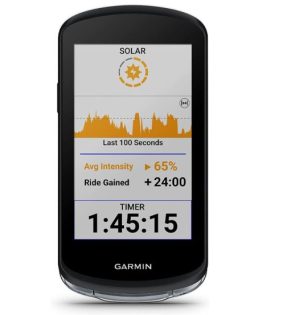
The Edge 1040 Solar can be charged using the sun, which is certainly a draw. According to Garmin, the Power GlassTM solar charging system increases battery life in energy saver mode by up to 42 minutes each hour, giving you up to 45 hours of battery life for “demanding use cases” and up to 100 hours overall.
The fact that this is predicated on the assumption of constant 75,000 lux levels throughout daylight rides is irrelevant. That basically implies that there is constant, brilliant sunshine, which you may certainly appreciate during summer rides but may not have as much of during the cooler months, depending on where you reside. Naturally, the level of cloud cover should meet your expectations.
The user interface for the Garmin Edge 1040 Solar has also been updated, and we found it to be much simpler to operate than on other Garmin models. You may skim through your recent activity history, training schedule, weather prediction, and more on the home page thanks to customizable data fields. The “glances” feature also allows you to view information like your recovery time.
The Power Guide is another intriguing feature; it creates a pace plan for the route you choose to assist you manage your efforts. All this technology is obviously expensive, but if you’re looking for a cycling computer that can handle it all, you won’t likely be let down.
Specifications:
Dimensions : 2.3″ x 4.6″ x 0.8″ (59.3 x 117.6 x 20.0 mm)
Touch screen: Yes
Color display: Yes
Display size: 3.5″ (88.9 mm) diagonal
Weight : 4.7 oz (133 g)
Battery life: Up to 45 hours
Great GPS Accuracy
Solar Charge
Excellent GUI
Smart Pacing Features
Slightly expensive
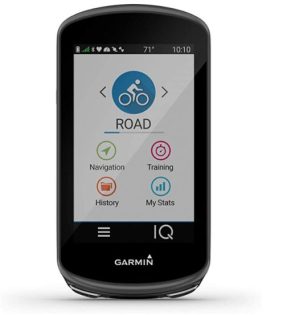
The 1030 Plus is substantial in both size and feature set. Its 3.5-inch display is both big and clear, making the on-device maps and data fields incredibly easy to see. Its exterior measurements are 4.5 inches tall, 2.3 inches wide, and 0.8 inches thick.
The Garmin 1030 Plus provides all the features you’d want in a high-end cycling computer, including navigation, training data, networking to external sensors and applications, access to the Connect IQ appstore, and much more. It can show all the metrics you may ever require. It supports WiFi for fast uploads to third-party programs like Strava as well as ANT+ and Bluetooth for connecting to sensors, smartphones, and Garmin wearables.
Specifications:
Dimensions: 58mm x 114mm x 19mm
Touchscreen: Yes
Color display: Yes
Display size: 3.5in (88.9mm)
Weight: 124g
Battery life: 24 hours
Features : Power, dynamic performance monitoring, sync training plans, lights, Live tracking, bike alarm, + many many more
Great Battery life
Best in features
Good touchscreen
Slick Setup
Slightly expensive
Bit heavy
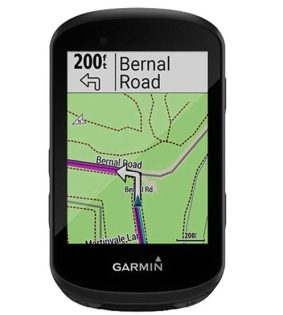
The 530 is the brand’s best option if you’re sold on Garmin cycle computers but prefer the tactile feel of button presses; it delivers the same feature set as the 830 and 1030 Plus but saves some money by skipping the touchscreen technology.
It costs about the same as the Wahoo Elemnt Bolt, which has a little smaller but higher resolution screen, but practically all settings on the Edge 530 can be accessed directly on the device itself, unlike the Bolt, which depends entirely on the companion app. A somewhat larger screen does make it a little bit easier to find where you’re heading while riding, but like the Bolt, the lack of a touchscreen does make for laborious map browsing.
Whether on a road or a trail, the Edge 530’s pre-installed Trail Forks and Garmin Cycle Maps can assist you in finding your way. The Garmin Connect IQ store is also accessible to the Edge 530, allowing you to add applications like Komoot, download data fields, and import workouts from TrainerRoad or Training Peaks.
Specifications:
Dimensions : 1.9″ x 3.2″ x 0.8″ (50 x 82 x 20 mm)
Touchscreen: No
Color display: Yes
Display size: 2.6″
Weight : 75.8 g
Battery life: Up to 20 hours (claimed)
Features: Power, sync training plans, lights, Live tracking, bike alarm, + more
Customizable
Intuitive to use
New performance matrices
Faster processor
Not easy to setup
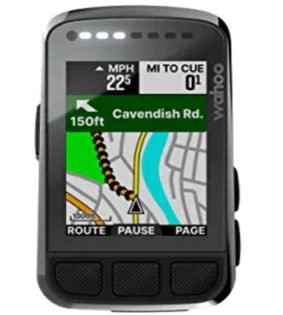
What we know and love about the Elemnt Bolt is now available in a little larger format with the Wahoo Elemnt Roam. The Roam offers all the essential features, including phone communication alerts, live tracking, and structured training, to name just a few, in terms of functionality and compatibility.
It is the most competitive alternative to the more expensive Garmin Edge 830, but it lacks a touchscreen, which may be an advantage for certain cyclists who cycle in inclement conditions and find this feature to be less than ideal. The unit’s three primary control buttons are strategically placed at the bottom of the device’s face; they are larger and simpler to use than the numerous bicycle GPSs’ small side-mounted buttons.
The battery lasts a few hours longer than the Bolt, albeit not as long as some of the other computers advertise.
Specifications:
Dimensions : 3.5″x2.3″x0.7″ (89mmx54.4mmx17.8mm)
Touch screen: No
Colour display: Yes
Display size: 2.7″ (68.6mm
Weight : 93.5g
Battery life: Up to 17hrs
Features: Integrates with smartphone app for turn-by-turn navigation, Bluetooth communication for text/call alerts, speed/distance/time/elevation, structured training
Easy to operate
Value for money
Great features
Great for off road adventures
Some may find low battery life
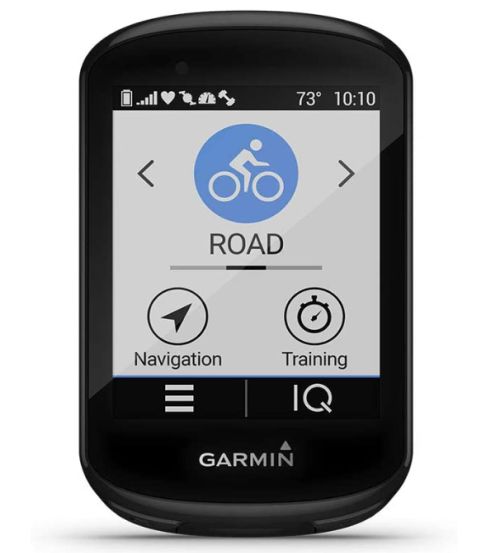
The Garmin Edge 830 provides the same abundance of mapping and training stats as the Edge 1030 Plus, but in a more compact and affordable package that will appeal to more people.
The smaller size entails a smaller 2.6-inch display, which in our opinion is still adequate for daily use, and a smaller battery, which we discovered to last about 18 hours before needing to be recharged. Naturally, the reduced size also results in a 42g weight reduction and, arguably the most desirable change, a lower price.
The Edge 830 can track everything from your speed, time, and distance to more intricate metrics like mountain bike grit and flow because it has access to the GPS, Glonass, and Galileo satellite networks as well as a vast array of built-in metrics.
It connects to smartphones and other apps using the Garmin Connect app, like other Garmin devices, and despite some initial issues, it got better as the flaws were fixed. Additionally, it means that it can simply connect to your Garmin watches, Varia radar, lights, and other Garmin devices because there is a complete Garmin eco-system for it to fit into. During our evaluation, we discovered that it connected with other branded products, including a variety of HR straps and electronic drivetrains, Wahoo’s smart trainers, Quarq, and Stages power meters, with ease.
Specifications:
Dimension : 1.9” x 3.2” x 0.8” (50 mm x 82 mm x 20 mm)
Touchscreen: Yes
Color display: Yes
Display size : 2.6″
Weight: 79.1 g (claimed)
Battery life: Up to 20 hours GPS training mode (claimed)
Features: Power, dynamic performance monitoring, sync training plans, lights, Live tracking, bike alarm, + many more
Easy to Install
2.6in touchscreen
Fast processor
Value for money
Useful size
Some may find bugs in software
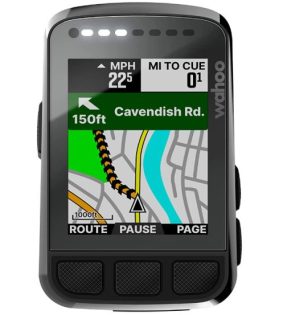
With the inclusion of a sharper display with more colours, a USB-C charging connector, more tactile buttons, and more memory, the Wahoo Elemnt Bolt combined all the positive aspects of the larger Elemnt Roam V1 into a smaller, aerodynamic design.
The entire ease of use is unmatched by other brands because setup and the majority of modifications are carried out using a companion app. It works perfectly, however it’s important to note that switching data fields mid-ride requires pulling out your phone rather than using the press-hold-change feature offered by Hammerhead and Garmin.
With its 64-color display, the Bolt’s maps are among the clearest and most concise in terms of exactly what is displayed, only surpassed by Hammerhead in our experience. However, the 2.2-inch screen is a bit too small, so serial navigators will be better off looking elsewhere. Connectivity to the Wahoo app and third-party navigation tools like Strava, Komoot, and RideWithGPS is seamless.
The Elemnt Bolt has compatibility for ANT+, Bluetooth, WiFi, and pretty much all the training metrics you’re likely to need. When it detects a WiFi signal, it will effortlessly sync your preferred third-party apps, making downloading routes and workouts and uploading rides as simple as it gets.
Specifications:
Dimensions: 3.05″ x 1.86″ x .84″
Touchscreen : No
Color display : Yes
Display size: 2.2 in
Weight : 2.4oz / 68.38 g
Battery life: 15 Hours Features: Power, GPS Navigation, Call/ text/ email, 15 county maps, SoS, Workouts
Aerodynamic design
Works well and durable
Value for money
Strava Live enabled
Screen easy to read
Aerodynamic design
No touchscreen
Cannot see the LEDs in sunlight
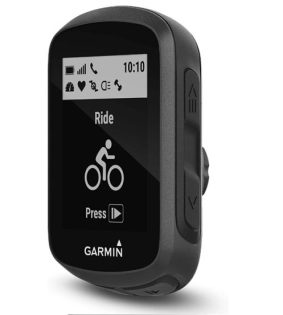
We are aware that our buying guide resembles a list of the top Garmin cycling computers, but that only serves to highlight the company’s dominance in the market. The Garmin Edge 130 Plus is no exception, having won a Cycling Weekly Editor’s Choice Award.
The Edge 130 Plus is a minimalistic, straightforward riding computer that is quite functional. It is simple to set up and updating data fields is simple to do, even on the fly, because buttons are used in place of a touchscreen.
It can pair with Bluetooth and ANT+ accessories including power metres, cadence sensors, and heart rate monitors. It is a gadget for individuals who wish to practise, improve their performance, and chase Strava Live segments but don’t require the high-end capabilities available at higher pricing.
Specifications:
Dimensions : 4.1 x 6.3 x 1.6 cm
Touchscreen : No
Color display: No
Display size : 27.0 x 36.0 mm; 1.8″ diag (45 mm)
Weight: 33 g
Battery life: Up to 12 hours (claimed)
Features: Power, lights, live track, GPS, navigation, text messages
Small size and looks great
Operate via buttons
The accelerometer allows for MTB metrics
Varia compatible
Easy-to-read screen
Black and white mapping
Lacking advanced power metrics

The Mega XL stands out among Lezyne’s selection of GPS-enabled bike computers as being the brand’s newest, largest, and best model. It shares many characteristics with its smaller brothers but distinguishes itself with a huge battery life claim of up to 48 hours, a sizable, readily legible display that can be used in either portrait or landscape configuration, and offline navigation and maps. It has too many features to list them all, but its lengthy battery life sets it apart from the competition. See how it compares by reading on.
The Mega XL is ideal for cyclists who love data since it has the info you want and displays it in the best way possible on a large 2.7′′ 240400 high-resolution screen.
The Mega XL can display data from power metres, heart rate monitors, speed/cadence sensors, and compatible electronic drivetrains while simultaneously pairing with Bluetooth Smart and ANT+ devices.
For more personalisation and functionality, the Mega XL may also be connected to Lezyne’s Smart Connect LED system and the Lezyne Ally smartphone app.
Aside from having a lot of incredibly helpful features like a barometer and accelerometer, trainer mode, numerous bike profiles, navigation, route creation, personalized alarms, and auto settings, this cycle computer is tough thanks to its weather-resistant casing.
Reasonably priced
Great companion app
Offline maps and navigation
Long battery life
Can be used in landscape or portrait orientation
No preloaded maps
Bit heavy
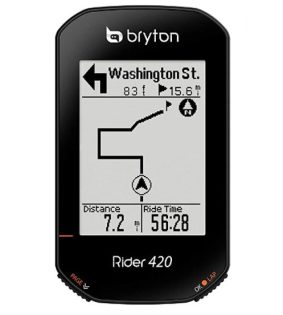
Bryton bike computers don’t have the best user interfaces on the market and have a bit of a learning curve, but once you get used to them, they give considerable value for your money.
You can build your own route and sync it to your device using a companion app for breadcrumb-style routeing. There are 77 functionalities, ANT+ and Bluetooth sensor support, and a battery life of 35 hours, according to the manufacturer.
The Rider 420 also enables auto-sync to third-party training software, the direct export of workouts from TrainingPeaks through the device, and the configuration of the screens and data fields via the companion smartphone app.
The Rider 420 might not be the ideal choice for you if you frequently follow routes, but if you’re looking for a lot of features at a low cost, look no further.
Specifications:
Dimensions : 9.4 x 9.4 x 4.57 cm
Touchscreen: No
Colour display: No
Display size : 2.3″ /5.8cm
Weight : 227g
Battery life: 35-hours 12-14hrs riding
Features : Power, GPS Navigation, text alert,
Amazing Battery life
Easy to set up
Easy to use
Value for money
User interface isn’t always intuitive
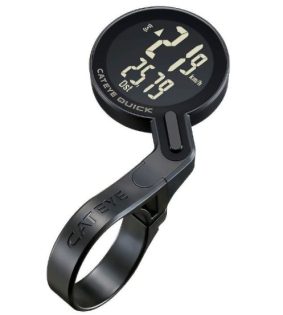
In terms of speed and distance accuracy, Cateye Quick was a digit for digit match for the more potent unit. Not bad for such a basic and, in the grand scheme of things, inexpensive equipment.
The out front location places it perfectly in the field of view and makes it simple to read quickly. Additionally, the battery life is measured in years rather than hours as it is with all of Cateye’s basic computers.
Functionality is constrained by the wonderful simplicity. Beyond the wireless speed transmitter, there is no compatibility, and as there is no GPS chip on board, there is no way to keep track of your travels. However, if you want a sleek and basic cycling computer and don’t want linked features, the Cateye Quick is accurate, reliable, and best of all looks really cool.
Specifications:
Dimensions: 93.5 X 54 X 36mm
Touchscreen: No
Color display: No
Display size: Not specified
Weight: 24g
Battery life: Approx. 1 yr (based on one hour a day use)
Features : Tracks distance, speed, elevation, pace indicator and time
Elegant design
Easy to use
Easy to install
Value for money
No GPS tracking
Best Road Bike Computers Buyers Guide
There are two key things to think about if you’re thinking about buying a new bike computer: First, how much money do you have to spend, and second, do you anticipate doing a lot of navigating on your computer?
If you don’t frequently use the map features on your computer, you might be able to save some money by purchasing a device that focuses more on providing essential information like ride time, speed, distance, averages, etc. while also having the ability to pair with devices like HR monitors and power meters.
You may need a computer with a larger capacity for more maps, more built-in GPS and navigational aids, and the ability to connect with other route planning programs if you plan to conduct a lot of navigating and route following on it.
What features can we expect from an entry level non-GPS cycling computer?
Typically, the most affordable cycle computers start at approximately the price of a takeout meal (or even cheaper if you do a bit of shopping around). Of all, you can’t expect a computer this expensive to have a ton of features.
The cheapest bike computers will gather this data from speed and cadence sensors mounted on the bike frame, to which they are wired, and use it to calculate basic metrics like your speed and cadence (and, from these, things like your average speed and average cadence).
You can upgrade to a wireless cycle computer by paying a little bit more, and it will link to your speed and cadence sensors without the need for unsightly cables to run all over your frame. If you’re on a tight budget and don’t care about uploading your rides to Strava or engaging in any real, planned training, these types of computers are probably your best bet.
Although generally speaking, unless you get one of a deal, it’s unlikely that these models will go quite as far as having a genuine GPS capable unit, just under a triple figure price tag will give you even more choice cycling computers-wise and they will begin to offer more capability.
What characteristics might we anticipate from budget GPS cycling computers?
With an entry-level GPS device, you can easily start tracking your rides and using additional functions. The price may increase slightly if you discover a bundle with a heart rate monitor and/or cadence sensor, but it will still be less expensive than purchasing the components separately.
Manufacturers emphasise simplicity of use, compactness, and light weight at this pricing category, which is often considerably below 3.5 oz/100g.
Your ride’s distance, time, speed, and lap times will normally be tracked by the GPS device, but it won’t offer navigation. Most systems provide ANT+ connectivity for external sensors and will automatically pause when you stop moving and resume when you do.
Typically, ride data is shown on a black and white screen in two or three rows. One of the selling advantages of these devices is that you can turn them on and start cycling without needing to go into complicated configuration settings, thus personalisation tends not to be a priority. However, there may be the opportunity to define which data elements and how many rows are presented.
The GPS might also let you set alerts for when you’ve accomplished a goal, like riding for a predetermined amount of time. You can purchase virtual competitor features to compare your performance to that of earlier riders who took the same route.
Battery Life on GPS Road Bike computers?
Do you like taking long bike rides for hours at a time through various regions of the nation?
You’re not the only one, after all. Now, tracking your data while you travel might be a lot of fun, but you might be concerned about battery life. But you’re in luck.
Different varieties of bike computers exist, but in terms of battery life, they are all very comparable. On the other hand, there is a significant difference between battery life between cellphones and cycle computers, with a cycling computer coming out on top.
Many computers advertise a battery life of 15 to 20 hours, though this can vary in specific circumstances. However, if you’re out for a particularly long time, external battery expanders can extend the life of your cycle computer’s battery so you won’t have to worry about your power meter expiring in the middle of a ride.
What Are ANT+ And Bluetooth?
ANT+ is a wireless technology that is frequently used to track sensor data in real-time or at predetermined intervals. It can be used to track heart rate during sports or tyre pressure, for example.
Bluetooth – Bluetooth is a wireless technology that enables the transfer of data over a short distance between various devices.
One way that ANT+ and Bluetooth are different from one another is that ANT+ allows for multiple-to-many connections while Bluetooth only allows for one-to-one connections.
Although many cycling computers now support both ANT+ and Bluetooth sensors, others still only support one or the other, so make sure to verify before you buy.
What do we expect from mid range GPS Road Bike Computer?
Spend a little more, and your GPS will start to have more features. Mid-level devices frequently include a cadence sensor or heart rate monitor as part of the package. They also offer a high degree of interoperability, so they may show and track data from your existing hardware, including any power statistics.
A mid-range device will typically be bigger, with a larger screen that can show more information, frequently in colour. The ability to store more data will likely also increase. Both buttons and a touchscreen can be used to operate the device, and many mid-range models also include mapping and navigation features. Some will just allow breadcrumb trails, while others might have base maps preconfigured or available for download.
Altitude data derived from GPS is less accurate than positional data because of how GPS satellite triangulation functions. As a result, barometric altimeters are frequently added to higher-spec units to improve height and ascent rate recording accuracy.
Many mid-range devices now support Bluetooth synchronisation with smartphones, allowing you to view calls, texts, and other data from the phone on your computer’s screen, such as weather warnings. Some computers can send information back to the phone, allowing it to upload rides without the use of a USB cord and communicate ride progress statistics to the internet for viewing by those you authorize.
What do we expect from high-end GPS Road Bike Computers?
High-end cycle computers are still in a state of arms race, with manufacturers seemingly introducing new, cutting-edge capabilities every few months. These items cost more than a quality road bike, weigh up to 7 ounces (200 grammes), and sometimes include a cadence sensor and a strap for a heart rate monitor.
You should anticipate a color touchscreen, mapping, turn-by-turn directions, and sophisticated training capabilities and integration at this pricing point. It might also offer route suggestions, WiFi access for data transfer, and the option to share a route with other riders.
These more expensive computers most likely integrate with other hardware and software. Most will sync seamlessly with workouts from third-party programmes like TrainingPeaks or Today’s Plan, show Strava Live Segments, and connect to electronic drivetrains.
These laptops’ enormous screens used to make battery life a problem, but these days you can anticipate a run duration of roughly 20 hours. All of these more expensive models will have access to various positioning satellite constellations, including the EU’s Galileo network, the Chinese BeiDou, and the Russian GLONASS.
How can we analyze our ride data from road bike computers?
You can download data from even the most basic bicycle GPS systems after a ride to the manufacturer’s ride-recording website and mobile app. The quality of the functionality and user interface varies, but many apps provide ride analysis, training plans, and social interaction. However, if the manufacturer’s website is inadequate, you can submit your data to Strava, Training Peaks, or other third-party websites.
Of course, if you have employed ancillary devices to record additional data, such as a cadence sensor or power meter, your analysis possibilities will be more varied.
How easy it is to setup a Road Bike Computer?
With newer models, setting up and configuring your riding computer has generally become much simpler. The designers make it simple for you to get out and ride, but if you require more complicated setup options, they generally provide them via a smartphone app.
The majority of the top bike computers follow a standard playbook in which a widget directs you through entering user data such as your language, height, weight, and age. In most cases, the computer will prompt you to download the most recent version of the software and, if it has a base map, the most recent update for your geographical area.
Most bike computers can be linked together using the manufacturer’s smartphone app. It is usually easier to interact when setup is done on the phone rather than the actual device.
How much should we spend on Road Bike Computers?
Just like anything else in cycling, it can be challenging to choose a bike computer that will meet your needs and budget while still providing the features you value.
Your GPS computer may have base maps, interval timers, detailed power metrics, a color touchscreen, and more connectivity than you can shake a stick at, depending on how much money you have to spend, or it may be a simple, portable device with a black and white display and fundamental training metrics.
You might have to give up some features if your budget is tight. In contrast, if you have a wish list of features, develop a checklist to determine which of the best cycling computers satisfies your needs, then analyse your options, taking price into consideration.
How much battery life is ideal for a Road Bike Computers?
Especially if you depend on your cycle computer for navigation or training data, how long you can enjoy being on your bike will depend on how long the battery lasts.
The best cycle computers often have a battery life of 15-20 hours when used sparingly, however this will be decreased if you combine it with several sensors or use it for extended periods of time while following directions.
A reduced battery life definitely won’t pose any problems while you’re riding because not many of us will be riding for 15 hours straight, but it will require more frequent charging.
Do we really need a touchscreen on Road Bike Computers?
The best bike computers include a decent mix of touchscreen and non-touchscreen gadgets; each has advantages and disadvantages depending on the type, location, and timing of your rides.
Without a question, a touchscreen device’s navigation is simpler and more intuitive because you can easily swipe to move around a map or pinch to zoom in and out. However, your dexterity to swipe through pages in this manner will be hindered if you frequently ride in the dead of winter and are wearing thick gloves, and buttons may actually make life easier.
Will you ever need to look at a map if you only ride on roads that you are acquainted with? Consider the kind of riding you undertake and consider what you most urgently require.
Likewise with color screens. They’re wonderful to have, but they almost often increase the cost, and they don’t really provide much outside of mapping outside a nicer look.
Final Words
Now that you are aware of the top bike computer, it is time to make a choice and include one in your basket.
Always keep in mind that you’ll want one with a lengthy battery life as well as all the features you’ll need to measure for your bike trips.
Our top pick from this list was the Edge 1040, which is unquestionably among the best GPS bike computers now on the market because to its long battery life, wealth of functions, and training data. It is also cadence sensor compatible and Bluetooth-enabled. However, whichever cycling computer you choose, make sure it is one you can use and, more importantly, that you feel comfortable purchasing.
Check out our guide on installing a bike computer if you need help attaching your computer.
But aside from that, it’s ultimately up to you, so make a sensible choice. If you’re hesitant to shop online because of the low quality and unreliable brands of some products, any of the five we’ve listed below will more than likely meet your demands.
Best Road Bike Computers Common FAQs
Are sensors included with bike computers?
The majority of devices provide basic information like speed and distance, but you’ll need to add additional sensors to monitor important information and increase accuracy. However, a lot of bike computers are bundled with those sensors when they are sold.
Can I use my iPhone as a computer for cycling?
So, is your iPhone compatible with a bike computer? Yes, you can, but unless you’re a casual rider, we wouldn’t advise it. It’s true that an iPhone can perform all of the functions of a bike computer, and it provides an extra layer of convenience because the majority of people own one, but they are prone to breaking while you’re riding, and the battery life can be a serious problem if you’re riding for more than two hours.
Do bike computers have GPS?
Without the use of cables or magnets, GPS cycling computers correctly calculate speed, distance, and time based on satellite tracking of your location. They keep track of your route and any data they gather, like as your heart rate, cadence, and power.
What should I look for in a bike computer?
One-of-a-kind versions can also track cadence, calories burned, elevation, heart rate, temperature, and a whole lot more. Key features include speed, distance, and odometer features.
People also checking similar Items
Contact Us
If you have any suggestions or advise, please feel free to reach us via our Contact Us here.
Giant Fathom 2
Beefed-up On natural rides, XC hardtail is enjoyable, but its geometry limits it on challenging trails. A robust, 120mm-forked hardtail with wide 650B rims, large tyres, and broad bars is called the Giant Fathom 2. It is a dependable companion for long rides on flat ground, but tricky, winding trails are where the short, lofty geometry and subpar Suntour fork let it down.
Overview
| Category | Bikes |
| Brand | GIANT BICYCLES |
| Model | Fathom 2 |
| Type | Mountain Bike |
| Year | 2022 |
Features
On paper, the Giant Fathom 2 appears to be a trendy item because it checks practically all of the must-have criteria. It features a dropper post, a 1x Shimano transmission, large disc brakes, and a fork with 120mm of travel. The icing on the cake is the fact that it also looks the part.
The bike’s 650b wheels are covered in 2.4-inch wide trail rubber and are tubeless ready out of the box, spanning the gap between plus- and standard-size tyres. I was expecting the bike to perform well on the trail because it doesn’t lack any essential components.
ALUXX SL Aluminum Frame
The sturdy, rigid frame is made of Giant’s ALUXX SL-Grade aluminum alloy. If you want to add extra gears, the bike has a place for a front mech, and the wires are run internally through the down tube before emerging right above the bottom bracket. They proceed from this point along the underside of the chainstays until they reach the mech and brake caliper.
Giant asserts that by joining the seatstays to the seat tube lower than the top tube, which is unusual, the bike’s ability to absorb bumps is increased and the back end feels smoother across difficult terrain.
A normal tapered head tube and a tapered fork are also included. Analyzing the figures reveals that Giant’s goals are somewhat ambiguous. Although Giant claims that the bike’s shape is trail-friendly, there are several numbers that caught me off guard. A 444mm reach and a 1,153mm wheelbase are a tad on the conservative side for the size big. Similar to how the 425mm chainstays imply that the bike is more dynamic than Giant initially disclosed,
Surprisingly, Giant chose a 67-degree head angle and a 45mm bottom bracket drop (with an off-the-floor height of 315mm), although I’d typically anticipate larger reach and wheelbase measurements to go along with those statistics.
Drive train a
The Shimano drivetrain doesn’t have a lot of range, but the Shadow+ Deore mech has a clutch, and I’ve used clutches before, so I know they’ll survive.
The Praxis Cadet cranks’ 30t narrow-wide-style chainring and the Shimano Deore 10-speed cassette’s gear range of 11 to 42 teeth should provide a sufficient gear range for the majority of trail conditions.
Tektro HDM discs with a 180mm front rotor and a 160mm rear rotor handle stopping.
Giant probably saves money by using Suntour for suspension functions instead of Fox or RockShox counterparts, however, at least on paper, the fork doesn’t fall short on features when compared to what the major brands have to offer.
During testing, the Shimano Deore drivetrain was found to be perfect, and the 11-42t cassette, when combined with the 30t chainring, provided more than enough gears for even the most tired legs or the toughest climbs.
Giant has accomplished a remarkable feat by using Shimano components throughout the drivetrain (apart from the cranks and chain), whereas other manufacturers choose less expensive cassettes to help with cost-cutting.
OverDrive
Technology for huge fork steerer tubes developed by Giant. The system’s enlarged headset bearings (1 1/4″ lower and 1 1/8″ upper for road, 1 1/2″ lower and 1 1/8″ higher for mountain) and tapered steerer tube work together to produce ideal steering rigidity. They are designed to provide precise front-end steering performance.
Tyres
The Maxxis Ardent tyres also manage to maintain an excellent balance between grip levels and rolling resistance, especially when worn tubeless. However, grip levels do decline noticeably as soon as conditions are very harsh, especially when very muddy.
Brakes
The bike’s Tektro brakes were undoubtedly the least impressive part because they lacked sufficient bite and force.
Their performance isn’t bad at all on flat ground, but as soon as the gradient increases or the speed increases, it’s possible to be caught off guard when approaching turns that call for significant speed to be scrubbed off rapidly.
Wheels, Tyres & Capability
It has reduced seat tubes to lessen the pain, however it’s debatable whether or not the 2.6-inch Maxxis Ardent Race tyres on Giant’s 30mm internal rims are more effective.
The EXO TR casing, which is naturally tubeless ready for even lower pressures, handles rocky impacts effectively while the tyres roll well even at low pressures.
The top tube slopes significantly for optimum standover clearance, but the bosses on the bottle cage prevent the Contact Switch dropper post from entirely squeezing into the seat tube; about 2.5 cm remain protruding. Although I tested a Large and am 185 cm, I had no trouble getting the saddle height correct at full extension, so the hassle was negligible.
Specifications
Check specifications here
Sizes | S, M, L, XL |
Colors | Black/Rosewood, Concrete |
Frame | ALUXX SL-Grade Aluminum |
Fork | Giant Crest 34 RCL, 130mm, Boost 15×110 |
Handlebar | Giant Contact Trail, 35 |
Stem | Giant Contact TR 35 |
Seatpost | Giant Contact Switch dropper post with remote, 30.9 |
Saddle | Giant Romero |
Shifters | Shimano Deore |
Rear Derailleur | Shimano Deore, Shadow+ |
Brakes | Tektro TKD143 [F&R] 2-Piston, 180mm Rotors [F&R] |
Brake Levers | Tektro TKD143 |
Cassette | Shimano Deore, 12-speed, 10×51 |
Chain | Shimano |
Crankset | Praxis Cadet Boost, 30t |
Bottom Bracket | Praxis, press fit |
Rims | Giant AM 27.5 wheelset, alloy, 30mm inner |
Hubs | Shimano Boost [F] 15×110 [R] 12×148, sealed bearing |
Spokes | Sapim |
Tires | Maxxis Ardent Race, tubeless, 27.5×2.6, foldable, TR |
Extras | Tubeless prepared |
Giants Demonstration
Pros & Cons
Pros
Fun to ride
Great specs
Tubeless Tyres
Confident ride
Responsive bike
Cons
Can be harsh on bumps
Conclusion
4.8
Total score
Our Rating
The Giant Fathom 2 is a charming hardtail that prefers rolling, undemanding natural rides that are more cross country than trail, despite its bulky appearance.
Push hard in the corners and you’ll quickly reach the limitations of its short, tall geometry, the basic fork, and the brakes. However, the soft, large volume tyres on wide rims, and 120mm travel offer it decent survival when things do get tough.
Frequently Asked Questions – FAQs:
Is Giant fathom any good?
It is a dependable companion for long rides on flat ground, but tricky, winding trails are where the short, lofty geometry and subpar Suntour fork let it down. What if the Tektro brakes performed similarly? There are two versions of the Fathom, with this one costing £200 less than the Fathom 1 supported by Rock Shox.
Does the giant fathom 2 have a dropper post?
You can quickly modify saddle height with a dropper seatpost and handlebar remote for secure placement on shifting terrain.
How many gears Giant Fathom 2?
The Fathom 2 is easier to ride up hills than similar bikes. The Fathom 2 won’t keep up with similar bikes while riding downhill or sprinting.
…
2021 Giant Fathom 2.
| Rear Derailleur | Shimano Deore, Shadow+ |
|---|---|
| Cassette | Shimano Deore, 12-speed, 10×51 |
| Chain | Shimano |
| Brakes | Tektro TKD143 [F&R] 2-Piston, 180mm Rotors [F&R] |
Is the giant Fathom 2 tubeless?
less tyre blowouts improved traction a smoother, faster ride, and less rolling resistance. All these advantages are now more accessible than ever thanks to Giant’s Tubeless System.
Contact Us
If you have any suggestions or advise, please feel free to reach us via our Contact Us here.
Our articles are developed after considerable research and studies online and also including seeking informational experience based tips from professional rides. Key sources of information are interviews, google search and youtube.
5 Resistance Band Exercises All Cyclists Should Do
To learn practical methods for working out at home to enhance you’re cycling. Resistance band training is an easy method to add variety to your exercises. Riding muscular endurance will improve your elasticity, mobility, and power on the bike. We provide some great techniques you may practice in this post. For some of these workouts, all you need are some resistance bands and some appropriate footwear.
A great technique to improve your strength, flexibility, and balance is with resistance bands. You can increase the efficiency and duration of your cycling by using resistance band exercises in your training.
Resistance bands come in a wide variety of forms, but generally speaking, the thicker the band, the greater the resistance. Having a collection of bands in various sizes and densities will allow you to utilize them for any activity.
You should work on strengthening your core as well as your legs because a solid core will help you maintain good posture while cycling and climbing hills. You’ll also be more likely to avoid damage by working not only your muscles but also the tiny tissues that surround your joints.
Warm-Up Session
Make sure you warm up correctly before beginning the “core” of this resistance band workout with 5 minutes of a variety of routines, including: Arm movements, Leaping a rope, rotating the hips, deep lunges, Squats. Now begin by walking while wearing your resistance band around your quadriceps. Your abductors and hip flexors will get a workout when you walk with a resistance band above your knees because the bands do what they are designed to do, which is to add more resistance.
The primary exercises should now be performed.
Resistance Band Exercises
Lattice-Banded Walk
You can increase your hip strength and flexibility by taking lateral walks. Tie a hip circle band around your thighs; alternately, you might encircle your feet’s middles with a thinner band.
Lean forward from the hips while you stand with your feet hip-distance apart.
To enter a quarter squats, slightly flex your legs.
Now walk sideways while maintaining your straight back (like a crab). To go to the other side of the room, take another ten steps.
Backtrack while putting the other foot in front of you. Ensure that the resistance band remains taut the entire time you are exercising.
Toe tap variation: While wearing the band around your thighs, perform the exercise while tapping your toes.

Plank with bands (with variations)
A great all-body workout is the plank posture.
Place a resistance band directly above your ankles and assume the plank position.
Once tap out to the side with your right foot, then bring it back.
Similarly, move your left foot.
Iterate as necessary.
Alternate side plank position: Lie on your left side with both legs straight and your weight on your elbow. Your right arm should be held straight up in the air as you stack both feet. Lifting your torso off the ground now requires the usage of your core muscles, particularly your obliques. Breathe out as you lift, then slowly inhale as you descend.
Remain inside plank position and elevate the upper leg to begin the resistance band portion. At the top, pause, then gradually lower it. You should experience the pain!

Bent over banded row
Curving rows exercise both the backs of your legs and upper back. Place your feet hip-width apart as you stand.
Holding the ends (or loops) of a long resistance band in each hand, place it under the middle of both feet.
From your pelvis, bend forward until your trunk is virtually parallel to the ground.
Pull the ends of the band toward your hips while maintaining a flat back. You maintain your arms close to your body while raising your elbows toward the ceiling.
At the top of the “row,” pause, and then gradually bring the band back down.
Iterate as necessary.

Squats as Band Exercise
In addition to working the rest of your lower body and your core, squats also work your gluts. It’s a great exercise for strengthening your muscles and enhancing your balance.
Squat as you typically would while holding a hip circle band over your knees.
You can spread your hands in front of you in a fist. Or you may wrap your wrists in a different band.
For a double burn, pulse your straight arms apart with each squat!
Just make sure your spine is firm, your chest is looking out, and your knees are not bent more forward than your toes. You can incorporate a jump between those squats to increase the difficulty. Jump out of the squat, then jump back down.

Cycling crunches Band Exercise
Cycling crunches exercise your hip, core, and quadriceps while imitating cycling motions.
Wrap the resistance band around both of your feet’s middles. Place your hands next to your ears as you lay on your back. Raise your legs so that the bottoms of both thighs are parallel. Now lift your chest while straightening your right leg until it nearly touches the floor. The left knee should be within reach of your right shoulder. Move carefully to maintain the band’s tension while you repeat the motion with the other leg and shoulder.

Shoulder Press Band Exercise
Make sure there is an equal amount of band on both sides when you stand on top of the band with your feet hip-width apart. With your hands facing away from your body and your arms straight, reach down and take hold of the handles as you raise them to shoulder height. By extending the elbows and stretching the shoulders, lift the arms overhead. In a controlled motion, bring your arms back to their starting position, then repeat.

Donkey Bandage Kick Band Exercise
Start out on all fours with your back flat, toes tucked, wrists under your shoulders, and knees under your hips. Holding onto one handle, wrap a resistance band around your left hand. Put your left foot inside the resistance band’s other grip. Stretch out and raise your left leg. Go back to your starting point. Continue with the opposite leg.

Maintaining Consistency
Keep in mind that regularity is essential for getting the best benefits from any cross-training programmed. Make a commitment to yourself to include resistance band training in your routine, gradually increasing the number of exercises and acclimating to the more challenging exercises as you gain proficiency.
If you are struggling with correct posture please focus on learning the correct posture and technique, search using google or youtube to find the most relevant posture for your exercise.
Band Exercise Common FAQs
How frequently should I use resistance bands per week?
Resistance training on two to three days per week, for the majority of exercisers, will be sufficient to maintain the gains in strength, health, and body composition.
Which resistance band suits novices the best?
Exercise programmers for beginners using light resistance bands
Resistance Band by SLOVIC. This resistance band, either the Bold fit Resistance Band or the FITSY Fitness Band, can be an excellent choice to take into consideration if you are just starting out on your fitness adventure.
Resistance loop bands made of FEGSY fabric and Fitlastics.
How often should I use a resistance band?
If you’re unsure, a fitness expert can help you choose the best band for you based on your level of fitness and your unique training schedule. Try aiming for 2 to 3 sets of 8 to 25 reps for the majority of workouts.
Can you cycle while using resistance bands?
You may exercise your upper body while riding a recumbent bike, did you know that? Use a resistance band and a recumbent bike to complete this full-body workout to exhaust both your upper and lower body.
Contact Us
If you have any suggestions or advise, please feel free to reach us via our Contact Us here.
Giant FastRoad E+ EX PRO
The Giant FastRoad E+ EX Pro has a really aggressive style that doesn’t try to disguise the fact that it’s an e-bike. With its large tyres and slick matt black paintwork, the EX Pro looks strong and prepared for work.
Overview
| Category | Bikes |
| Brand | GIANT BICYCLES |
| Model | FastRoad E+ EX PRO |
| Type | Electric Bike, Recreational Bike |
| Year | 2023 |
Features
The FastRoad E+ EX Pro is a speedier and more enjoyable way to travel thanks to its Yamaha-powered SyncDrive Pro engine, new Giant EnergyPak Smart Compact 500 battery, and smooth-riding aluminum frame. It is designed with a small, lightweight SyncDrive Pro motor that provides power that feels natural and effortlessly combines with your own pedaling forces to let you to travel farther and faster with less effort. Everything you need for your everyday excursions is built into its lightweight ALUXX SL aluminum frame, which also features an integrated rack, fenders, light mount, and kickstand.
ALUXX SL Aluminum Frame & Weight
It’s surprising to realize that for an e-bike, it’s not actually that heavy. For the medium-framed variant, the Giant FastRoad E+ EX Pro weighs in at a fairly acceptable 20.1kg it seems surprisingly nimble for a “fully-loaded” electric bike. The average weight of mid-drive hybrid electric bikes appears to be around 25kg. While many hybrids have a suspension fork, the Giant employs a significantly lighter ALUXX Ally fork.
All of the finishing equipment, including the frame and forks, is manufactured of aluminium using Giant’s ALUXX SL technology. The EX Pro has a “D-Fuse” seat post that is intended to boost rider comfort, and it comes with all the extras a cyclist could possibly need. The Giant has a full set of mudguards, a sturdy pannier rack, a kickstand, and strong built-in lights that are powered by the battery. For a stock item, the saddle is actually very comfortable.
Sync Drive
Gaint’s Sync Drive Pro motor, one of the best e-bike motors, pulls like a train in Sport mode and offers enough of torque. It will easily carry you up even the toughest peaks.
The top-of-the-line Sync Drive Pro motor, created in partnership with Yamaha, offers an astonishing 360% of assistance (with 80Nm of torque) in the maximum power mode. This can be adjusted using the app to further customize the riding experience to the demands of the rider.
Despite having a continuous power output of 250w, the Giant Sync Drive Pro motor is silky smooth, silent, and offers an outstanding amount of assistance.
Battery & RideDash Evo
A 500Wh battery pack offers a great potential range; if you use the assist sparingly, you may get up to 100 miles on a single charge. Although the average rider’s mileage is likely to be lower, the average ballpark figure appears to be between 50 and 60 miles, which is plenty for a couple hours in the saddle. The battery pack can be taken out and charged with the included 6A charger.
One of the newest Giant displays, the RideDash Evo color display, is loaded with practical functions including navigation. If you link the companion app, you can post your rides to fitness monitoring websites like Strava and use a heart rate monitor.
Gearing
Giant has employed a blend of road and gravel components to help create the FastRoad a really flexible machine, and the gearing setup on the EX Pro is very great. A gravel-specific GRX rear derailleur, which includes a clutch mechanism to prevent the chain from slapping around on rougher, bumpier terrain, is teamed with 10-Speed Shimano Tiagra flat-bar shifters. The only thing I would change about this is that I believe they should have chosen an 11-42 cassette for a wider gear range instead of the 42t chainring up front and the 11-36 rear cassette. However, the motor has sufficient torque to make up for this.
Brakes
Shimano MT-200 hydraulic brakes are quite entry-level, and at this price, I would have anticipated slightly higher-spec brakes. Although I weigh 17.5 stone and there are several -15% descents close to where I live, these brakes are more than adequate for the ordinary rider. I use them on my own electric bike, and they have never let me down.
Wheels, Tyres & Capability
The FastRoad EX Pro’s all-terrain qualities are obvious; the Giant tackles harder terrain with relative ease thanks to its high capacity 27.5′′ x 240mm multi-surface tyres. This e-bike might be ideal for longer, more difficult trips.
Giant has combined their robust EX-2 tubeless-ready rims with Performance Tracker thru-axle road hubs with sealed bearings; these rims are 27.5′′ in diameter (as opposed to the standard 28′′ / 700c) and are made to withstand the rigours of off-road riding better. The FastRoad EX Pro will be able to handle dirt, canal walks, and woodland trails with reasonable ease when equipped with the Kenda Kwick Seven.5 high volume tyres.
Specifications
Check specifications here
| Motor | Giant SyncDrive Pro |
| Controller | Giant RideControl Ergo |
| Display | Giant RideDash EVO |
| Battery | Giant EnergyPak Smart Compact 500Wh |
| Sizes | XS, S, M, ML, L, XL |
| Colors | Black |
| Frame | ALUXX SL aluminum |
| Fork | ALUXX SL-grade Aluminium, 12×100 thru-axle |
| Handlebar | Giant Connect XC Riser 31.8 x 690mm |
| Stem | Giant Contact |
| Seatpost | Giant D-shape, Aluminium |
| Saddle | Giant Sport |
| Pedals | Aluminum Platform |
| Shifters | Shimano Tiagra, 10-Speed |
| Rear Derailleur | Shimano GRX RX400 |
| Brakes | Shimano BR-MT200, hydraulic disc, 180/160mm |
| Brake Levers | Shimano BL-MT201 |
| Cassette | Shimano Tiagra, 11-36, 10-Speed |
| Chain | KMC e.10 Sport |
| Crankset | Forged Alloy minimal Q-factor, 42T |
| Rims | Giant eX-2, Tubeless Ready |
| Hubs | Giant Performance Tracker Road, Sealed Bearing |
| Spokes | Sapim E-Lite [r] Race [f] |
| Tires | Kenda Kwick Seven.5 27.5 x 2.40 (61-584), 60TPI, w/ reflex |
| Extras | Giant EnergyPak 6A Smart Charger, Giant EnergyPak Plus range extender compatible |
| Lighting | Axa BlueLine 50 frontAxa Blueline rear |
| Carrier | Giant Rack-It MIK |
Giant Presentation
Pros & Cons
Pros
Fun to ride
Elegant design
Tubeless Tyres
Lightweight bike
Responsive bike
Cons
None noted
Conclusion
4.8
Total score
Our Rating
I think the Giant FastRoad E+ EX Pro is a fantastic bike; it will be a wonderful choice for a rider who wants to spend some time on tougher terrain without having to carry as much weight as the typical mid-drive hybrid e-bike.
It’s undoubtedly designed for the more daring rider who wants to explore more untamed terrain, but it will also be a great bike for navigating the urban jungle because it can handle potholes and badly maintained roads with ease!
The FastRoad EX Pro would be a great option if you were searching for an electric bike to do some light touring and made smart plans so you could charge it every evening. For long days in the saddle, it is completely furnished and quite comfortable. You can obtain quite a good range between charges if your route is moderately hilly and you don’t always use full power.
The Giant Sync Drive Pro motor is a true gem; it consistently receives high ratings for dependability and generates a smooth and powerful surge of electric assistance when you need it. What’s even better about this motor is that when you do go beyond the 15.5 mph limit, the transition is seamless and you can pedal it as a regular bike (albeit heavy one).
Despite how much I enjoy riding bikes like the Cube Kathmandu, if given the option, I believe I would always choose a bike like the Giant. It feels more like a “regular bike” and is 6 pounds lighter. It comes very well equipped and is a lot of pleasure to ride.
Frequently Asked Questions – FAQs:
What is Shimano HG700?
Road cassette sprocket for the SHIMANO 105, 11-Speed, HG-EV, 11-34T. Low climbing gears make the HG700-11 cassette, which is compatible with GS cage rear derailleurs, perfect for cycling over various terrain. It functions with freehubs that have speeds of 10 and 11.
Is Giant FastRoad a road bike?
The rider of this ground-breaking flat-bar road bike is in a relaxed position for fluid and efficient movement. It is built on an Advanced-Grade Composite disc frameset that is lightweight and has a smooth-riding composite fork.
Are Trek road bikes better than giant?
In a rather close race, bikes from Trek and Giant compete against one another. Giant’s bikes are often more cheap and have higher-quality parts than Trek’s, despite the fact that Trek frequently has more innovative designs. Both businesses provide high-quality motorcycles in a variety of categories.
What size Giant bike do I need for my height?
| Conventional Size (Equiv) | Sizing | Rider Height | Rider Height (cm) |
|---|---|---|---|
| 49-51cm | XS | 5′ 2″ – 5′ 4″ | 157 – 163 |
| 51-54cm | S | 5′ 4″ – 5′ 7″ | 163 – 170 |
| 55-57cm | M | 5′ 7″ – 5’10” | 170 – 178 |
| 57-59cm | M/L | 5′ 10″ – 6′ 0″ | 178 – 183 |
| 58-60cm | L | 6′ 0″ – 6′ 3″ | 183 – 191 |
| 61-63cm | XL | 6′ 3″ – 6′ 6″ | 191 – 198 |
Contact Us
If you have any suggestions or advise, please feel free to reach us via our Contact Us here.
Our articles are developed after considerable research and studies online and also including seeking informational experience based tips from professional rides. Key sources of information are interviews, google search and youtube.

